
This Grilled eggplant in tempered spices or Tadka Baigan was, as if a modern preparation with a desi soul, just like Big Z.

Big Z turned sixteen… she was merely eight-year-old when my blog started! Today’s recipe is much like her, at least in temperament. Grilled Eggplant in tempered spices… baby eggplants in a spunky tadka of Indian spices. I used a mishmash of cooking techniques… grilling as well as a traditional chaunk or the tempering with whole spices roasted in pungent mustard oil and then poured onto the grilled eggplants. It was a burst of colours as well as flavours.

I also tried out a variation of Doi Begun, the Bengali preparation of eggplant in yoghurt (below). This turned out to be equally amazing, so might keep it for another post. In Doi Begun, eggplants are fried and then cooked in a yoghurt gravy. In my version, I added some whipped yoghurt with spices to the eggplants and grilled them, before adding the tempered whole spices.

The tadka baigan or grilled eggplant in tempered spices was, as if a modern preparation with a desi soul, just like Big Z. For her birthday lunch, however, she demanded to be surprised. We did manage to surprise her, which is a feat in itself considering that we are staying at home together all the time these days. We celebrated amidst screaming and screeching and zoom parties and cakes and surprises and hopefully everything that our young lady wished for. Do catch me on my instagram stories if you would like to see the feat and the feast!


Do keep safe, stay blessed and may you occasionally burst into colourful and flavourful surprises just like my Grilled Eggplant in tempered spices!
Unblogging it all… Ishita
Thank you for joining me on my daily food and travel journey on Pinterest, Instagram, Facebook and Twitter!
Some recipes that Big Z likes: Homemade Nutty Spreads – Almond, Cashew & Hazelnut Happy Cinnamon Rolls that you can make at home Stuffed Chilli Spring Rolls
Disclaimer: This isn’t a sponsored post, nor are there any affiliated links for any of the brands that may have been mentioned in this blogpost. The subject, story, opinions and views stated here are my own and all images are from my personal album. While you enjoy reading my posts with lot of visuals, please do not use any material from these posts.





18 baby eggplantsGrilled Eggplant in tempered spices

Ingredients
6 green chillies, sliced longitudinally
3 dried whole red chillies
3 bay leaves
5 tbsp black mustard seeds
3 tbsp whole coriander seeds
2 tsp turmeric
3 tsp red chilli powder
3 tbsp cumin powder
3 tbsp coriander powder
½ cup mustard oil (stronger the better)
salt as per tasteMethod

The potato in Kolkata Biryani is my favourite part of the dish. In this Awadhi style of cooking, the dum pukht technique allows the the aromatic juices from the mutton to ooze into the fine grains of rice.
They say the way to a man’s heart is through his stomach. It’s certainly true in my case, but if I were to be specific about the kind of food, it would be Biryani and Mughlai food. Not any Biryani, but the Awadhi/Lucknowy style Mutton Biryani that we grew up eating in Kolkata. The Bearded Biker’s love for Awadhi Biryani made us hop into Lucknow for an evening, only to eat. His Biryani love has now been transmitted to the Z-sisters and myself too in a big way… so much so that Big Z wanted us to take the first flight out to Lucknow, once her GCSEs got over!

If I may coyly declare, I think have perfected the art of cooking the Biryani in the style of Shiraz Golden Restaurant. To celebrate the Bearded Biker’s birthday, we had a chef who used to work in Shiraz Golden Restaurant, come home and cook. The menu was as per his liking – Mutton Biryani, Chicken Chaanp, Galawati Kababs and Lachha Parathas. While the chef cooked everything at home, we ordered the Lachha Parathas from Arsalan (located in Karama), another popular Mughlai restaurant from Kolkata. I learnt from the chef as he cooked, while noting down every single ingredient and technique that went into making each dish. This was a Pakki Biryani where the rice and meat are semi cooked separately and then arranged in layers in a pot and cooked in the Dum Pukht style. As I had expected from Mughlai cooking, the process was elaborate and time consuming. But if you are a keen cook, making the Kolkata Biryani at home would be quite engaging and stimulating. Before this Biryani hangover is over, I promise you that homemade Lachha Parathas and Galawatis are coming your way!

Kolkata Biryani can spark a huge debate – who serves the best Biryani in Kolkata? Did the addition of aloo, potato in the Awadhi Biryani downgrade its status? The Nawabs were known for their culinary indulgence and some argue that they certainly wouldn’t have approved of the humble aloo and attribute it to the financial difficulties of the Nawab in his later years. However, the great-great-grandson of Nawab Wajid Ali Shah (Kolkata’s Mughlai food heritage is attributed to the Nawab), thinks otherwise. As this article indicate, in those days potatoes were considered exotic and addition of potatoes in the Biryani was a result of one of the many kitchen experiments that the Nawab indulged in. The addition of aloo was approved heartily by the Nawab and has since then become Kolkata Biryani’s culinary heritage.

Royal Indian Restaurant in Kolkata (set up as early as in 1905) always considered aloo in the Biryani, a culinary blasphemy. I remember meeting Gulam Nabi, the head chef of Royal, a descendent of the direct lineage of the khansama of Wajid Ali Shah in my Ramadan food trail with Kolkata Walks. I was told that ‘Royal would die out rather than introduce aloo and deem in their Biryani. A total no no!’. Well, it seems that Royal too had to succumb to the Bengalis’ love for aloo… and introduced the versatile ingredient in their legendary Biryani for the first time when they opened a branch in Park Circus in 2015.

Although the Awadhi cuisine has travelled far and wide, nowhere has it settled down strongly as it has in Kolkata. Mohammed Wajid Ali Shah Bahadur (1822 AD-1887 AD), the Nawab of the princely Indian state of Awadh or Oudh (which is modern day Lucknow), was a well-known food aficionado. Kolkata Biryani is cooked in the Dum Pukht style, where the meat, rice or vegetables are covered and sealed in a copper or an earthen pot with a dough of flour. Everything is then let to cook in its own juices on a very slow flame. This Dum Pukht style of cooking can be traced to the Nawabi kitchens of Awadh. Exotic nuts, herbs and aphrodisiacs went into the Dum Pukht meals that were cooked for the Nawabs.

In 1857 AD, when the Awadh kingdom was annexed by the British, Nawab Mohammed Wajid Ali Shah Bahadur was exiled to Calcutta (today’s Kolkata). His passion for gourmet food travelled from Lucknow to Kolkata and was nurtured, garnished and fuelled by his special Bawarchis – the Chefs of the Nawab. It is believed that only a handful of chefs with royal khansama or lineage knew the secrets to the authentic Awadhi Cuisine. Each Mughlai restaurant in Kolkata today, however, claims to have one such gem working in their kitchen. While the meat to rice ratio in their Biryani varies, so does the secret ingredients that go into making their Biryani special and unique!

Our Biryani nostalgia mostly centres around Shiraz Golden restaurant in Park Circus. The budget for our parties during my college days would allow a packet of Special Mutton Biryani (special would mean an egg in the Biryani), a plate of Chicken Chaanp and a Firni for each person. The menu was always the same – budget was limited but our love for Biryani was unlimited.
Serving the Biryani is an art too. In the restaurant, the Biryani is scooped along the sides of the pan with a quarter plate, digging deep into the bottom layer and bringing up pieces of mutton and aloo with the fragrant Biryani rice. The Biryani rice sporadically erupts into the yellow and white rice, much like fine poetry.
The potato in Kolkata Biryani is my favourite part of the dish. In this Awadhi style of cooking, the dum pukht technique allows the the aromatic juices from the mutton to ooze into the fine grains of rice. Needless to say, it has to be Mutton Biryani and it has to be special… meaning there has to be a stark white egg staring back at me!
Unblogging it all… Ishita
Thank you for joining me on my daily food and travel journey on Pinterest, Instagram, Facebook and Twitter!
Dessert recipes that will complement your Biryani: Semaiya Kheer or Vermicelli Pudding Firni or Ferni - The broken rice pudding
Disclaimer: This isn’t a sponsored post, nor are there any affiliated links for any of the brands that may have been mentioned in this blogpost. The subject, story, opinions and views stated here are my own and all images are from my personal album. While you enjoy reading my posts with lot of visuals, please do not use any material from these posts.
4 cups basmati rice, extra-long grained ones (I use the sella basmati, a parboiled variety used to make Biryani in specialised restaurants) Whole spices 2 tsp white pepper, powdered 100 ml rose water For marination of mutton *Biryani masala 3 cups flour to make the dough for the dum For garnish For the Mutton For the Rice Layering of the BiryaniKolkata Biryani

Ingredients
2 kg mutton (10 pieces/kg of meat with bones, as that leave a unique flavour than the boneless ones)
6 medium sized onions, sliced thinly
8 big potatoes cut into halves
8 eggs, hardboiled and deshelled
6 star anise
4 pieces 1-inch cinnamon sticks
6 black cardamoms
2 tbsp ginger-garlic powder
4 tbsp special homemade Biryani masala*
100 ml kewra water
½ cup alu bukhara or prunes, dried
2 cups white oil
500 gms ghee
salt – to taste
2 tsp sugar
½ cup milk
1 tsp saffron
2 tsp yellow food colouring (This is optional. You may use saffron soaked in milk)
1 tsp Meetha attar or Biryani flavouring
500 gms yoghurt
4 tbsp ginger-garlic paste
4 tsp red chilli powder
½ papaya, finely grated
½ cup cashews, grinded into a fine paste
4 tbsp Biryani masala*
For 100 gms of Biryani masala, grind together the following:
30gms javitri or mace
30gms cinnamon powder
5 gms chhoti elaichi or green cardamom
25 gms gulab patti or rose petals, dried and crushed
5 gms jaiphal or nutmeg
5 gms cloves
1 muslin cloth (optional)
Dried fruits like cashews and raisins, pan-roasted in slight ghee (this is optional. However, I avoid any garnishing with dried fruits as the Bearded Biker isn’t too fond of it and feels it likens his Biryani into a Pulao)Method
The chef was very adamant that the Biryani had to be served it with a simple light raita made with yoghurt, grated cucumber, carrots and a pinch of salt. Keep the focus on the Biryani and open the seal just before serving. Don’t forget to add the plain boiled eggs.


Binangkals are deep-fried dough ball coated with sesame seeds and originates from the Philippines. They are quite similar to the regional favourite Leqaimats which are traditionally consumed during Iftar in the holy month of Ramadan, but less sweet.

Eid Mubarak! I am sharing Lady M’s recipe of binangkal that I recently shared with Khaleej Times. Binangkals, according to me, are the Filipino version of Middle Eastern Leqaimats. In the Philippines, binangkals are popular munchies with tea and coffee and sold at roadside stalls and regular bakeries. Lady M has been living with us for for more than 12 years now. Over the years she has learnt to cook Bengali and Indian food from the internet and my cookbooks and makes the most delicious dishes from all over the world. She has also introduced a lot of Filipino food in our Bengali kitchen. The recipe proportion she follows here is gathered over the internet and from her friend who works in a bakery. I felt that binagkal would be a fitting tribute to the essence of not only the holy month of Ramadan culminating with the Eid celebrations but also living in the UAE, a melting pot of so many different nationalities.

Dubai and the UAE has been our adopted home for the last two decades and now the time has come for us to relocate. Lady M is also moving into another loving family. We are grateful to have her in our lives – she’s been an integral part of our family, another mother to the Z-Sisters, my partner in all our kitchen experiments. We once made a Bengali and Filipino fusion dessert, which is still one of our favourites of all times. No bidding goodbyes please … may we continue celebrating togetherness, cherished memories, inspired food stories, a mishmash of cultures and cuisines wherever we are – with leqaimats and binangkals!
Unblogging it all… Ishita
Dessert recipes that you might like making for Eid: Semaiya Kheer or Vermicelli Pudding Firni or Ferni - The broken rice pudding Moong Daaler Payesh or Yellow Lentil Pudding



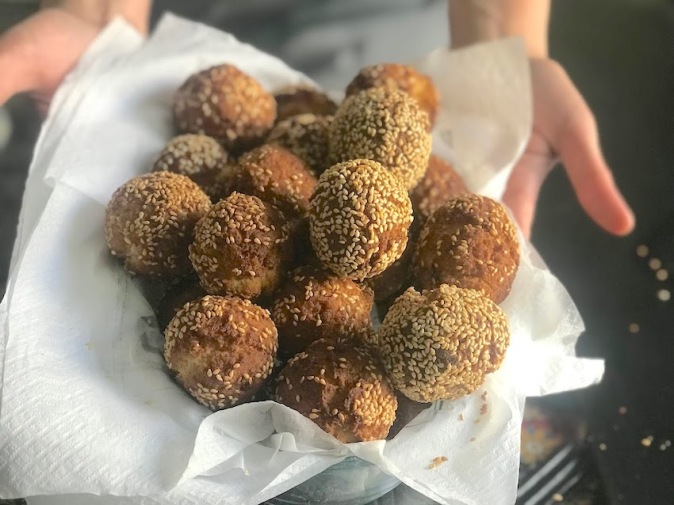
2 cups all-purpose flourBinangkal
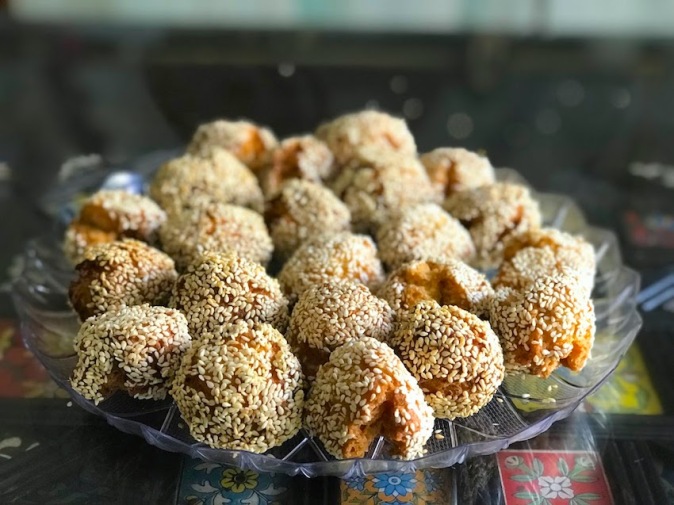
Ingredients
½ cup sugar, powdered
¼ cup corn starch
½ tsp baking powder
pinch of salt
½ cup cream
1 egg
1 tbsp white oil
2 cups white sesame seeds, for coating
white oil, for deep frying (you will require generous amount)Method
Thank you for joining me on my daily food and travel journey on Pinterest, Instagram, Facebook and Twitter!
Disclaimer: This isn’t a sponsored post, nor are there any affiliated links for any of the brands that may have been mentioned in this blogpost. The subject, story, opinions and views stated here are my own and all images are from my personal album. While you enjoy reading my posts with lot of visuals, please do not use any material from these posts.

The kitchen is the central focal point in our home around which all of us are orbiting eternally… much like the sun in our solar system!

We cook everything at home – Bengali recipes picked up from my mother or mother-in-law, friends, various blogs and different social media platforms, the multiple cookbooks that I have collected over the years, much of which are signed from the authors and chefs who have penned them… and last but not the least, food inspired by our travels. Ever since we became evolved bakers (we imply the Z-Sisters and Lady M, while the Bearded Biker and I are mostly into hands-on cooking, however elaborate it may be), it was time to transcend beyond simple breads… and boundaries. 
Making Acharuli, the stunning boat shaped Khachapuri or Georgian cheese-bread at home was highly thrilling. It was a collaborative project between Big Z and Lady M and the outcome was not only successful but soul-satisfying. Khachapuris are cheese-filled breads and are shaped in various ways. Traditionally, the cheese that is used is a regional cheese called sulguni. The acharuli khachapuris originated from the Adjaran region in Georgia. Over and above the generous cheese-filling in each bread-boat, a big blob of butter and an egg yolk sat right in the middle!
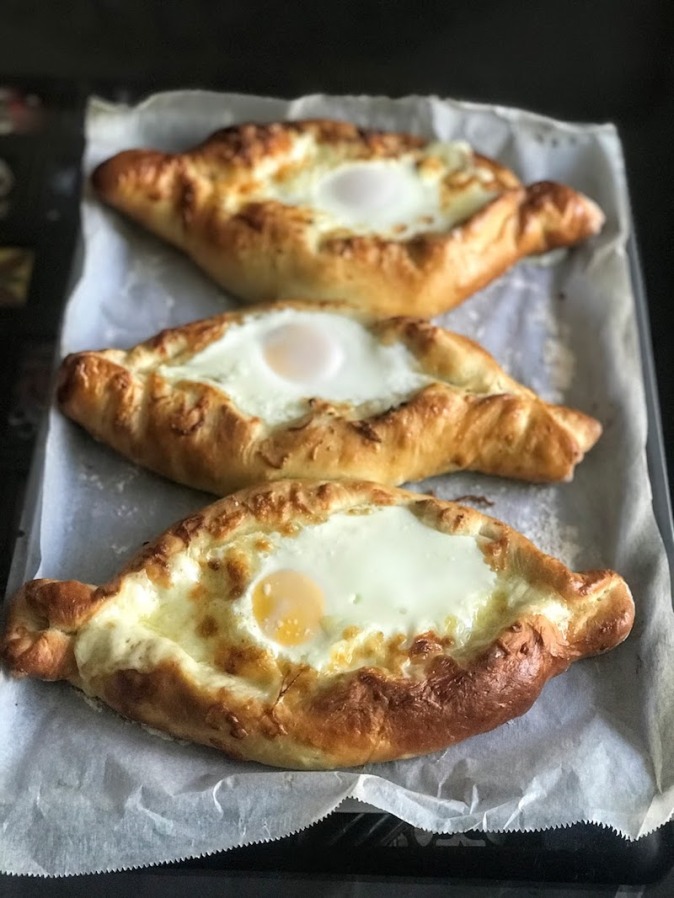
You can find the Acharuli recipe in www.foodemag.com, the food and travel website that I am a co-founder of. The recipe has been shared by Alice Feiring, an American journalist and author who visited Georgia in 2011 and wrote the book ‘For the Love of Wine’. The recipe uses shredded haloumi as a substitute for the regional cheese sulguni (the author suggests that you could also try mozzarella) and crumbled feta cheese.
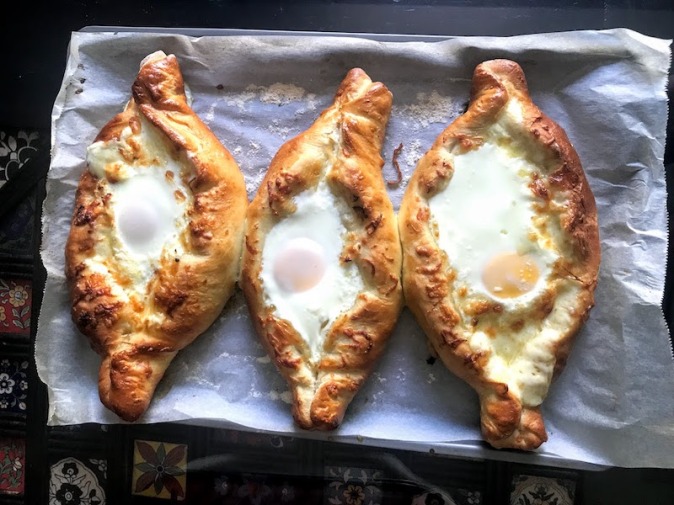
My family tasted their first acharuli in Telavi, Georgia’s wine region Kakheti. It was my second visit to Georgia, hence already a self-proclaimed connoisseur of Georgian food. Our guide led us through the diverse cultural and culinary heritage of Georgia over lunch in a restaurant that overlooked the beautiful Caucasus range. We learnt about the Adjaran region from where the acharuli originated, lay in the coast of Black Sea and the ethnic group Lazis inhabiting the region were mainly sailors. The shape of the acharuli – the cheese filling and the egg yolk represented the boat, sea and the sun respectively!
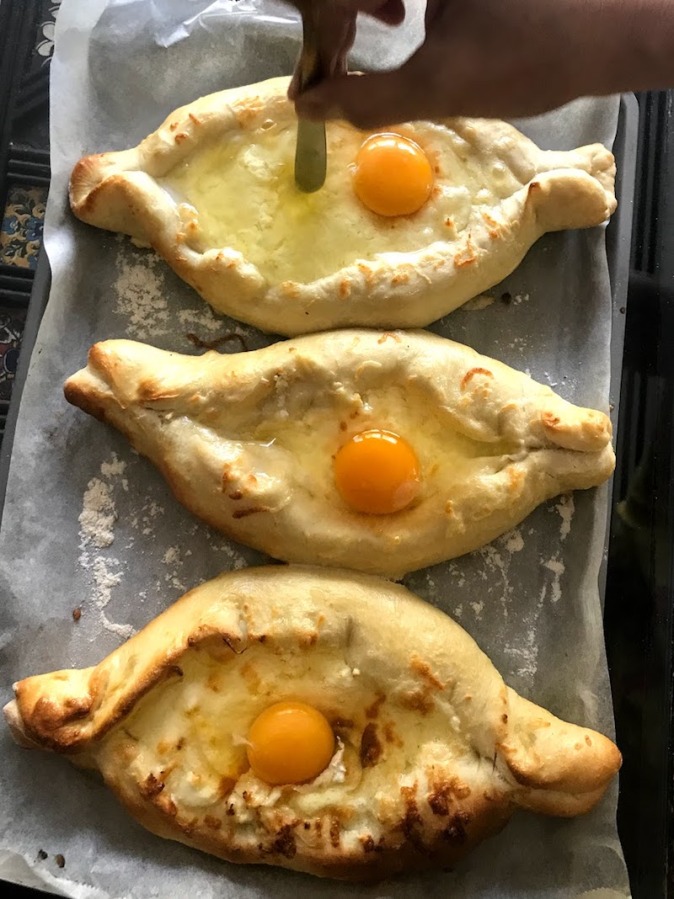
If you are confident with your dough-making skills, making acharuli at home shouldn’t be very difficult. Our acharulis turned out to be exactly how we had tasted in Georgia. They had to be eaten immediately out of the oven with the egg yolk staring bright yellow and still intact. The mission, as I had learnt in Georgia, was to make a gooey mess as you stirred the egg yolk in the piping hot filling of cheese. In our case, by the time the entire family assembled at the table, the egg seemed slightly cooked. This turned out to be quite a boon in disguise. As Big Z pointed out, it was better to avoid eating raw food at the moment.
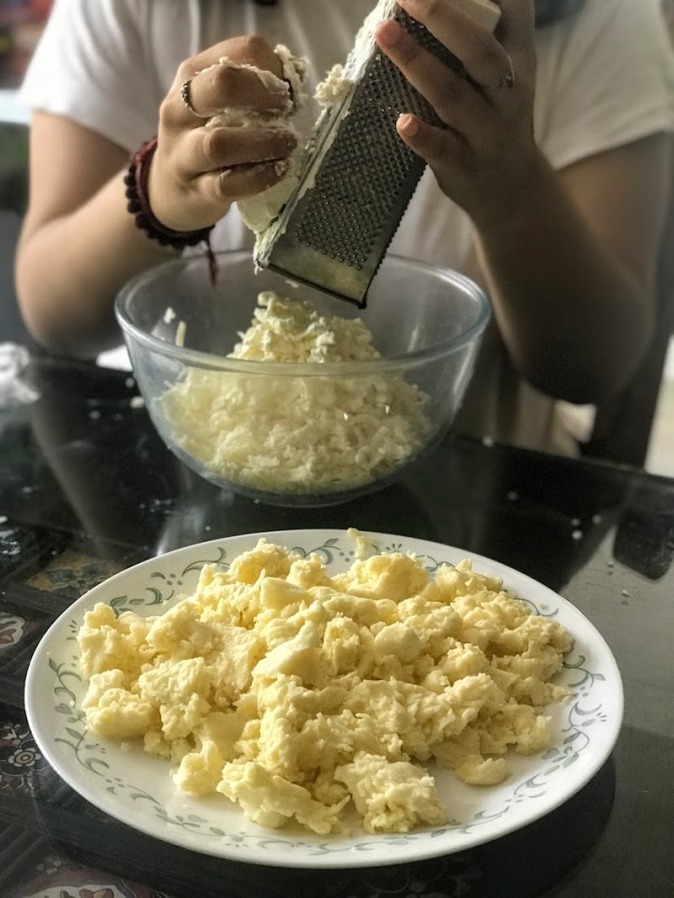
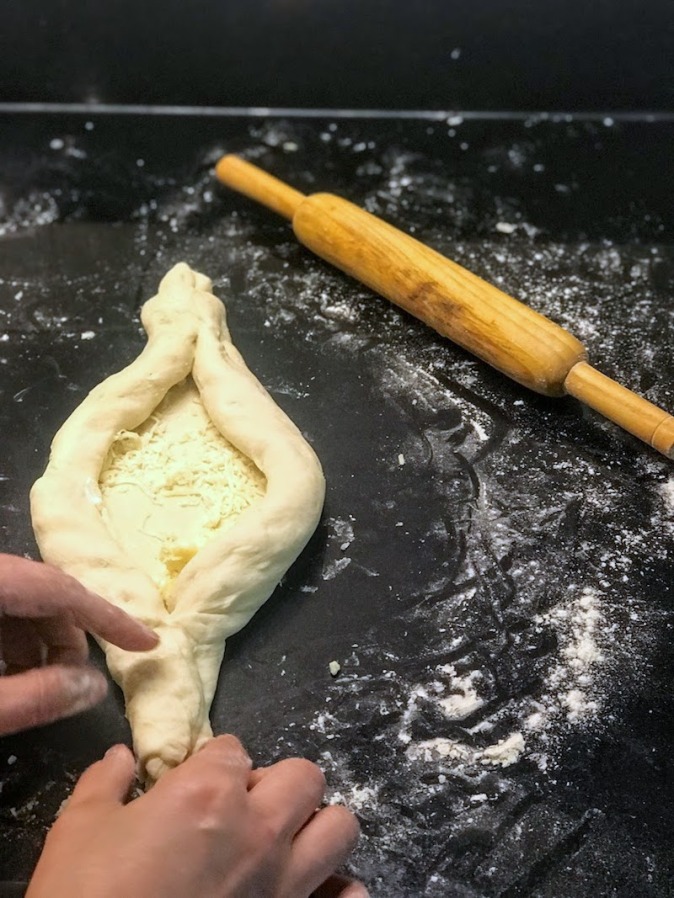
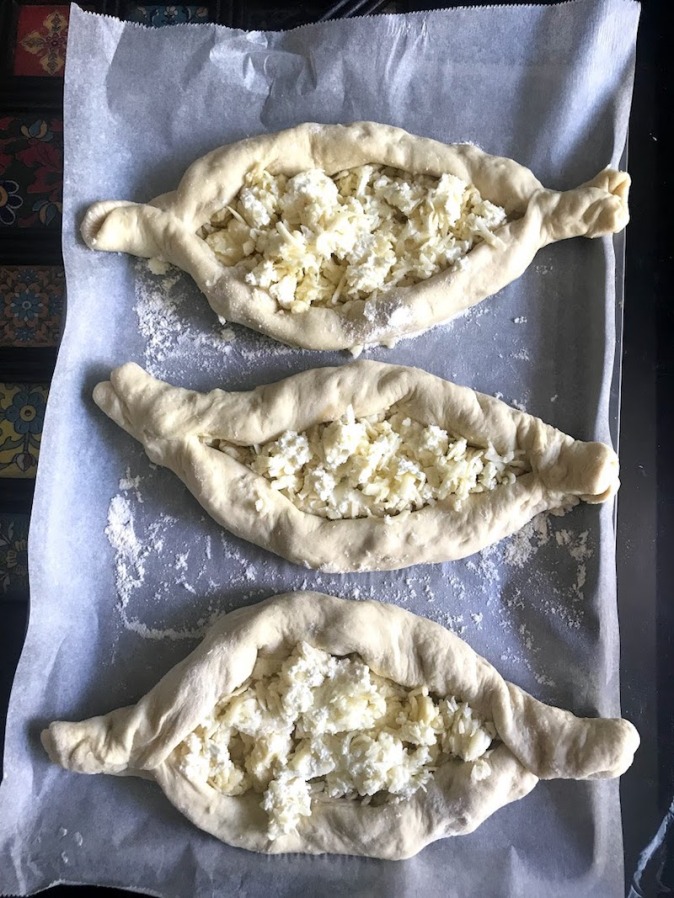
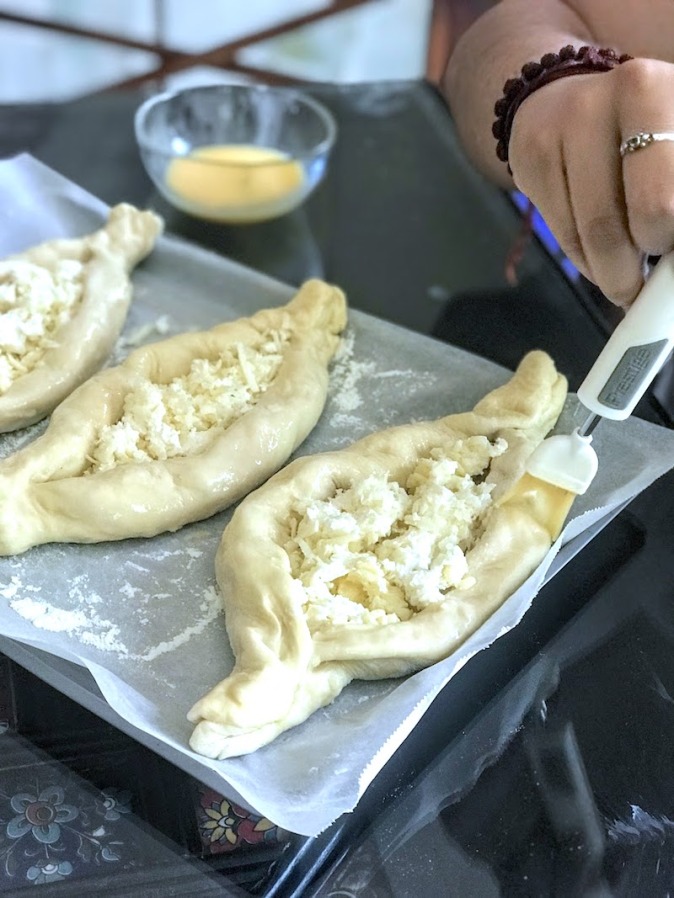
Tasting Acharuli in Georgia
There are many regional variations of khachapuris and one of our best food memories in Georgia are from a roadside family restaurant in Pasanauri, We didn’t taste acharuli there, instead, drooled over another type of khachapuri – Pkhlovana. Filled with salty Ossetian cheese and beetroot leaves, the pkhlovana khachapuris were fried crispy in sunflower oil. We visited Georgia during spring and what a sight to behold all around. Flowers bloomed everywhere, specially cherry blossoms. We randomly stopped to buy sweet cherries, plums, peaches and other fruits sold by the countryside. At Telavi, we made our wishes as we hugged a 900-year old plane tree. The Giant Plane Tree was the oldest plane tree in Georgia and amongst one of the many fauna wonders that the country flaunted during spring.
Saving the best for the last – in our last night in Georgia in Tbilisi, we came across a giant Acharuli in the popular Georgian fast-food chain called Samikitno. It had three egg yolks on top of the generous cheese-filling and had been appropriately named the ‘Titanic Acharuli’! The acharulis that we made at home may not have been as giant as the one in Tbilisi, they could be if we wanted them to be. The successful outcome, however, is in itself a giant step in our evolution in bread making at home!
Hope my food story inspires you to explore or revisit different countries through their cuisines, from your kitchen and home!
Unblogging it all… Ishita
You might like trying out what we've been cooking up at home recently: Thai Papaya Salad Recipe Homemade Bread with Sprinkled Sesame Stuffed Chilli Spring Rolls Happy Cinnamon Rolls
Thank you for joining me on my daily food and travel journey on Pinterest, Instagram, Facebook and Twitter!
Disclaimer: This isn’t a sponsored post, nor are there any affiliated links for any of the brands that may have been mentioned in this blogpost. Our Georgia vacation was self-paid. The subject, story, opinions and views stated here are my own and all images are from my personal album. While you enjoy reading my posts with lot of visuals, please do not use any material from these posts.

You can take a Bengali out of Bengal, but clearly not Mishti – sweets, out of a Bengali!
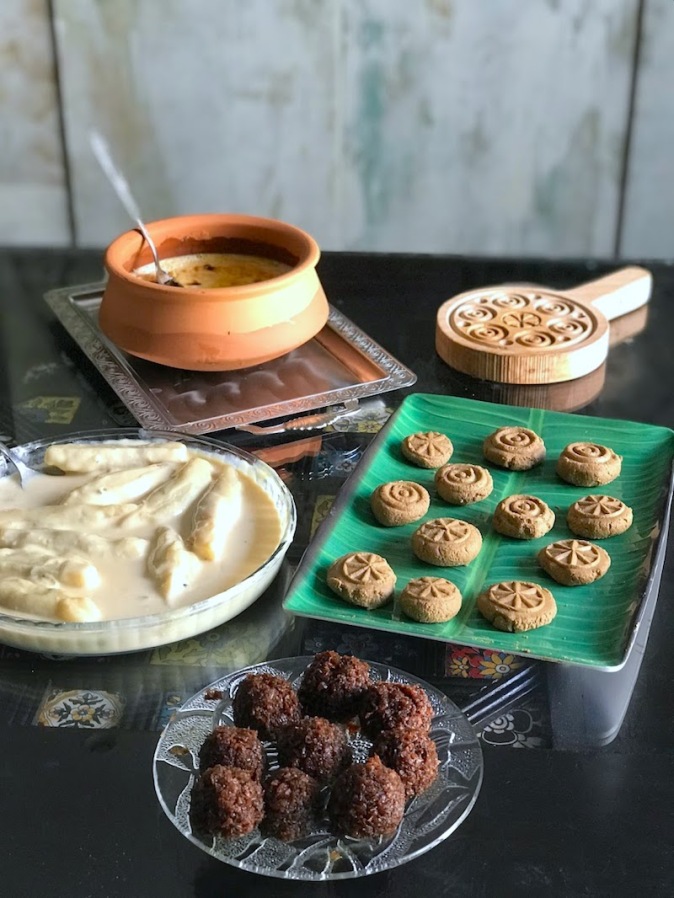
Shubho Noboborsho to all of you! Today was a working day and since everybody is either working or studying from home these days, I thought of keeping the Noboborsho lunch menu simple, but special. Li’l Z loves the Bengali prawn delicacy – Chingri Maacher Malaikari and Big Z longed for Bhapa Mishti Doi – steamed sweet yoghurt. She makes me feel quite special every time she declares that I make the best mishti doi in the world, although I must admit that it’s not a traditional recipe but a tweaked one. I decided to make two different preparations for prawns – a malaikari, cooked in coconut milk and a spicy Shorshe Chingri Bhapa. In the latter preparation, the prawns are delicately steamed in mustard paste and green chillies, raw mustard oil poured on top. In addition to the above dishes, I felt it would be pretty fair to have another mishti since it was after all, the Bengali New Year. You can take a Bengali out of Bengal, but clearly not mishti out of a Bengali. On that note, I was pretty bemused with this news from back home – amidst the country wide lockdown, sweetshops have been given permission to keep open for four hours in West Bengal to cater to the Bengalis’ sweet cravings!
We decided on making Dudh Puli, rice flour dumplings with coconut-jaggery filling… all deliciously dunked in a thickened kheer. As it always does in our kitchen (#gratitude), one sweet led to the other. There was extra filling for the pulis, so that led to some Narkel Narus, the coconut-jaggery truffles. There was extra Gur or jaggery, so I thought, well … why not make some Makha Gurer Shondesh too? I am sharing the recipe – it’s not too sweet and pretty easy to make. Made from fresh homemade chhena (cottage cheese), this shondesh is called makha because it is kneaded until it’s soft. If you have shondesh moulds at home, they make pretty shapes too. From my precious kitchen collectibles, I used a special wooden mould that is used in this part of the world (Middle East) for making Ma’amouls. Ma’amouls are very popular here – pastry with date fillings inside and are decorated by hand or shaped by wooden moulds. Well, isn’t that an inspiring take of my Makha Shondesh on Ma’amoul moulds?
May only good memories and amazing things spill out from the magic hat at all times to sweeten your lives, no matter what!
Unblogging it all… Ishita
You may like trying out some Bengali sweets: Moong Daaler Payesh or Yellow Lentil Pudding Bhapa Mishti Doi Notun Gurer Payesh Shondesh/Sandesh Pudding
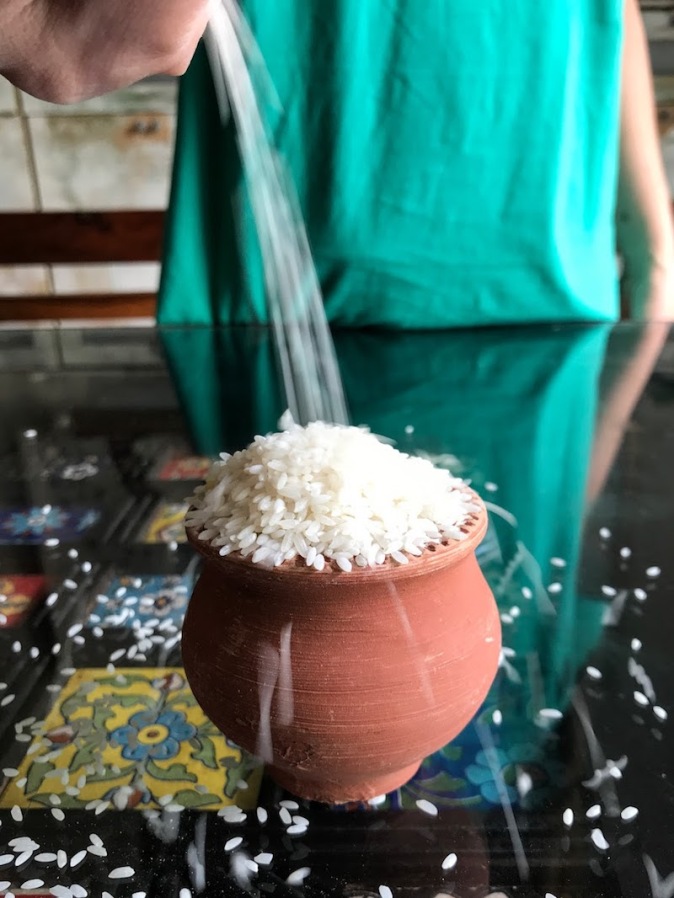
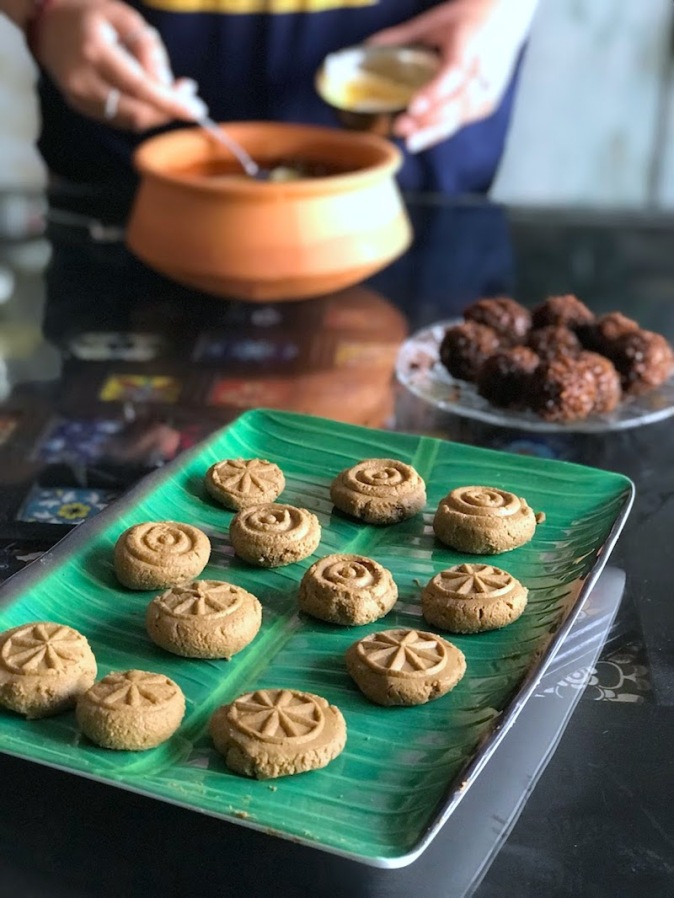
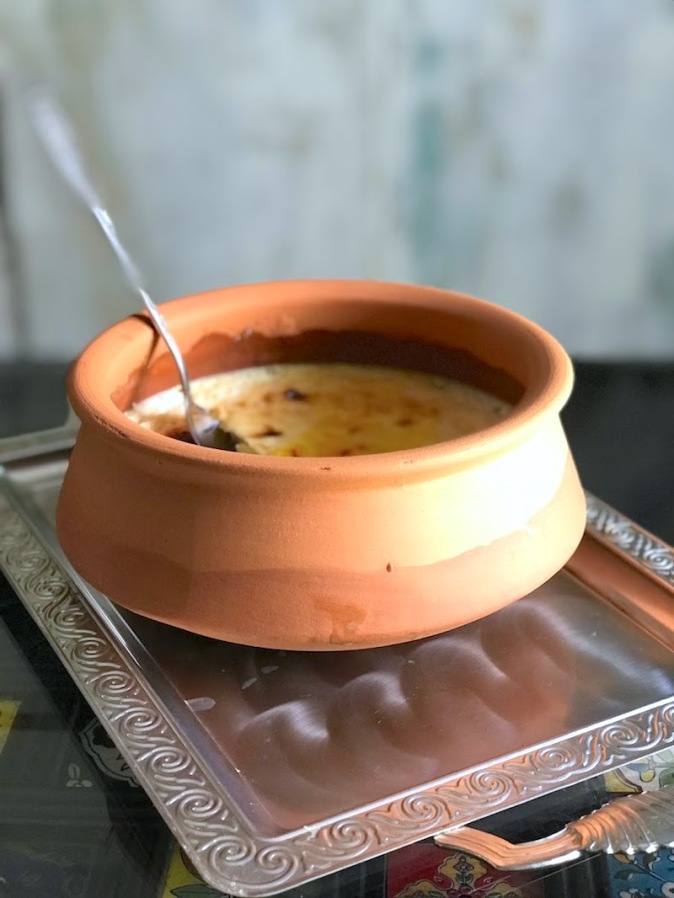
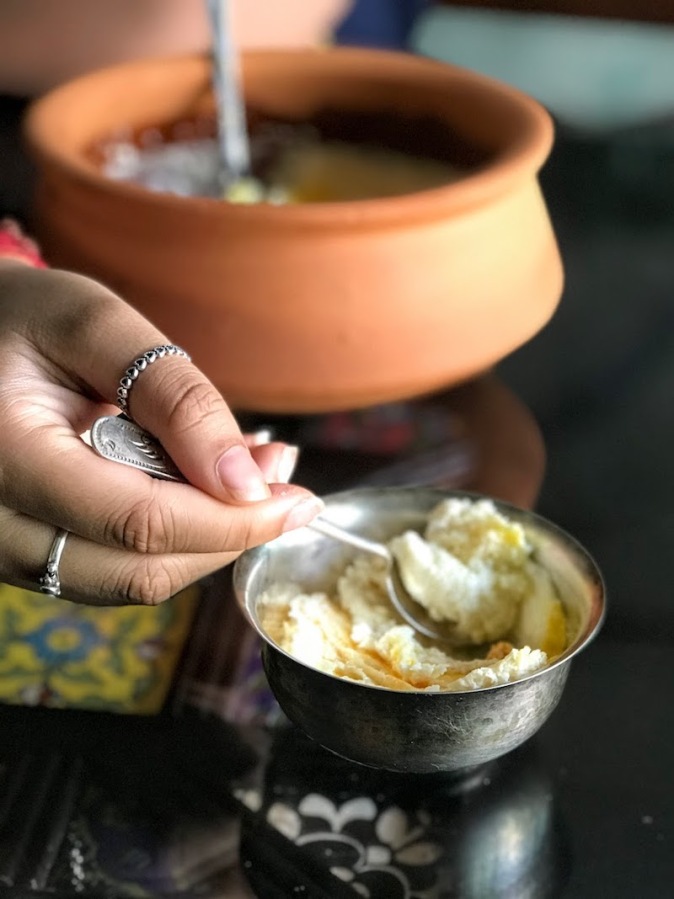
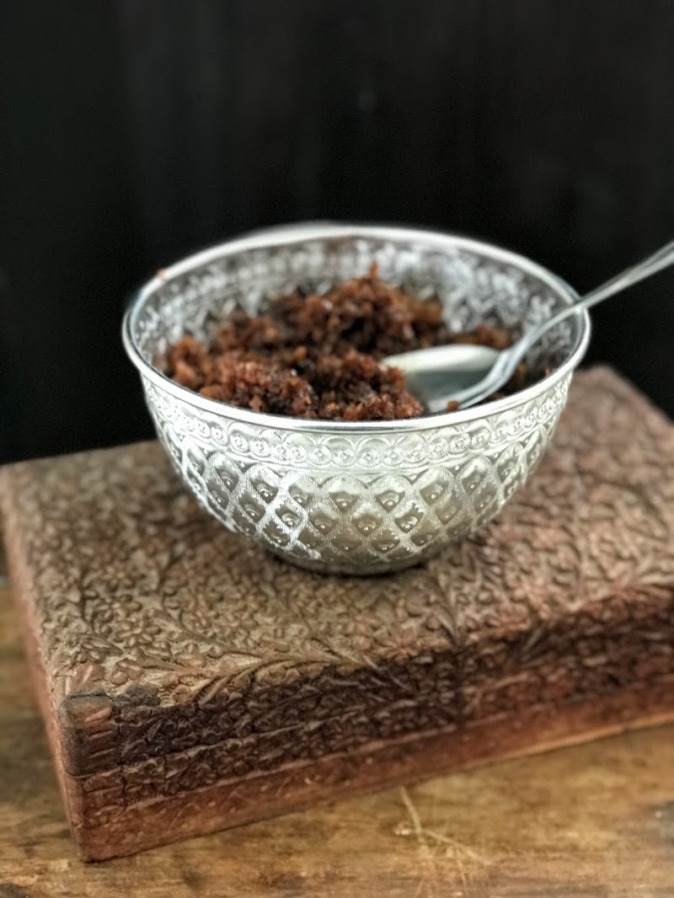
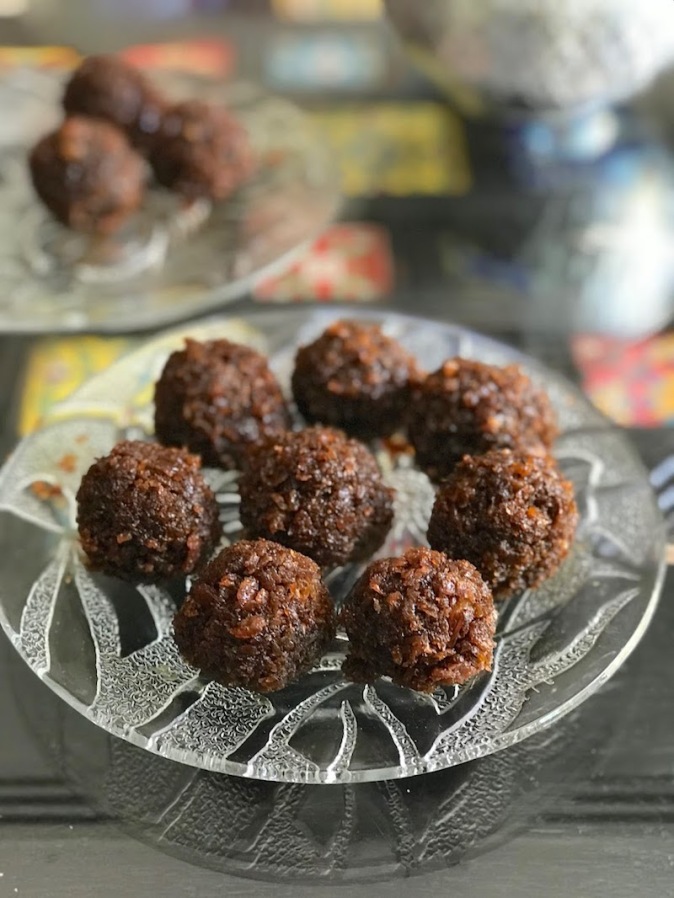
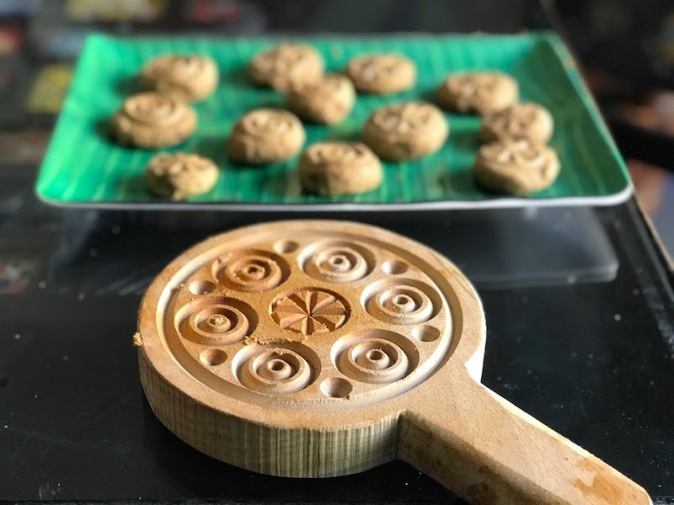
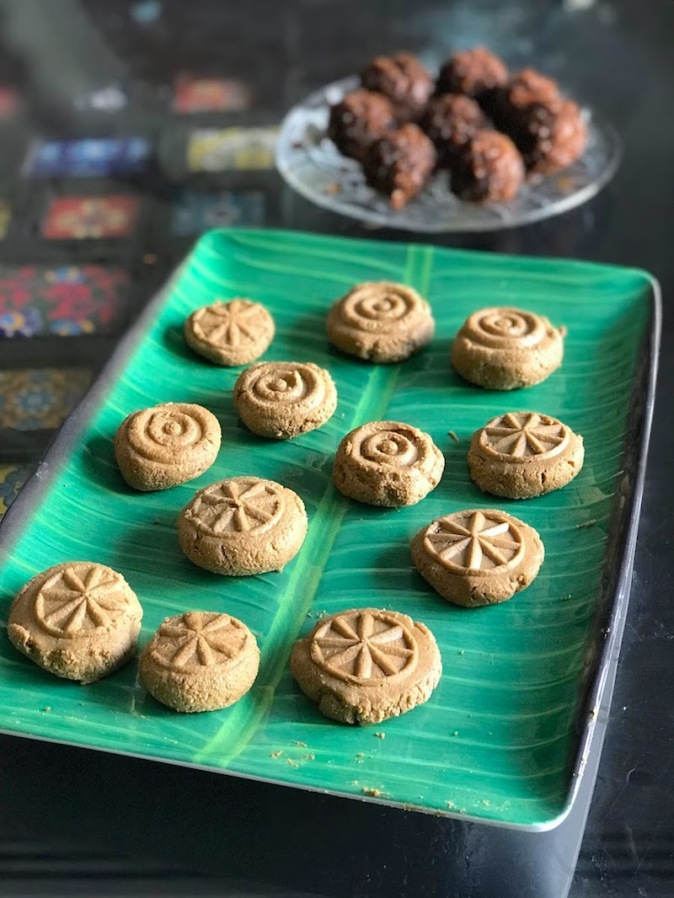
1 litre full fat cow’s milkMakha Gurer Shondesh
Ingredients
1 lime, squeezed into juice
100 gms date palm syrup (these are readily available in supermarkets here. Traditionally, however, season fresh nolen gur is used and I too prefer to use the latter if its available)
½ tsp of rice flour (you can use flour)
½ tsp of cardamom powdered, preferably crushed from fresh cardamoms
1 tsp ghee to brush the surface of the mouldMethod
The internet today is overloaded with information on COVID-19, do read and absorb whatever is necessary and adhere to the tips and advices that the respective authorities of your country of residence are sharing with you.
Thank you for joining me on my daily food and travel journey on Pinterest, Instagram, Facebook and Twitter!
Disclaimer: This isn’t a sponsored post, nor are there any affiliated links for any of the brands that may have been mentioned in this blogpost. The subject, story, opinions and views stated here are my own and all images are from my personal album. While you enjoy reading my posts with lot of visuals, please do not use any material from these posts.

I love my time in the kitchen, specially the feeling that comes with being brushed off by a teen daughter who knows what she’s doing and is completely in charge of the kitchen!

Go Nuts! Literally that’s what we did over this weekend – Big Z, in particular. She busied herself by making spreads from all the nuts she could find in our kitchen counter – almonds, cashews and hazelnuts. It was a conscious decision on her part not to put any extra add-ons like coconut oil or sea-salt, in spite of the constant temptation from our internet wisdom. While making homemade nutty spreads was mostly Big Z’s initiative, it was also partly this mama’s practical quest to chance upon substitutes to keep the Z-Sisters away from the Nutella and peanut butter jars that emptied as soon as they entered our home. Could homemade spreads actually turn out as good as they are made out to be? Oh, absolutely! All of them turned out rich, creamy and magnificently delicious. Specially, the cashew spread. I can’t wait for breakfast tomorrow, to lather one of these joyful spreads on a piece of toast of our delicious homemade bread. Big Z plans to have a spoonful with her oatmeal. She spent a lot of time making these spreads (bless her!) because we don’t have a high-speed blender at home. I find most kitchen gadgets like food processor and others cumbersome and difficult to clean, preferring smaller gadgets like a mini dry grinder and a hand blender. But if you have one at home, making homemade nutty spreads should be like a cakewalk. Well, that could be an idea for a treat – a simple homemade vanilla cake with a hazelnut spread.
A simple homemade spread transformed itself into a spectacular treat – I’m sure love was the single-most important ingredient. Along with dollops of gratitude. Stay safe, have fun… and spread lots of joy!
Unblogging it all… Ishita
You might like trying out what we've been cooking up at home recently: Thai Papaya Salad Recipe Homemade Bread with Sprinkled Sesame Stuffed Chilli Spring Rolls Happy Cinnamon Rolls





2 cups raw cashews Additionally, for Hazelnut spreadNutty Spreads - Almond, Cashew & Hazelnut

Ingredients
2 cups raw hazelnuts
2 cups raw almonds
2 tbsp cocoa powder unsweetened
1 tbsp sugarMethod

The internet today is overloaded with information on COVID-19, do read and absorb whatever is necessary and adhere to the tips and advices that the respective authorities of your country of residence are sharing with you.
Thank you for joining me on my daily food and travel journey on Pinterest, Instagram, Facebook and Twitter!
Disclaimer: This isn’t a sponsored post, nor are there any affiliated links for any of the brands that may have been mentioned in this blogpost. The subject, story, opinions and views stated here are my own and all images are from my personal album. While you enjoy reading my posts with lot of visuals, please do not use any material from these posts.

This is our favourite Som Tam or the Thai Green Papaya Salad … it’s a very easy recipe to stir up. I tweaked the recipe a bit from a fridge magnet that I had collected on my Thailand trip. Every time we make it at home, the familiar sights and sounds from the trip comes alive.

Travelling to places – far away or even as close as your neighbour’s house, seem to be a distant memory. So does tasting new cuisines at different restaurants or food events. Every day, I keep rearranging our collection of fridge magnets that hold so many beautiful memories of our travels – our family vacations and my press trips, or souvenirs gifted by our friends from their holidays. May we continue gathering all images collectively, associated with all our beautiful memories. That’s the only forward to positively impact every person, who’s ever been part of our travel experiences – street-side vendors, small cafes and restaurants, hotels etc. It doesn’t really matter who they are… vendors, suppliers, creators, planners, marketeers… we are all in this together.
Today, I’m sharing the recipe of our favourite Thai Green Papaya Salad, or Som Tam… it’s a very easy recipe to stir up. I tweaked the recipe a bit from a fridge magnet that I had collected on my Thailand trip (image further below). Every time we make it at home, the familiar sights and sounds from the trip is alive. Refresh your travel memories by cooking dishes from different cuisines from your travels. Just to emphasise on the importance of keeping your good memories alive, I used this old album as my canvas backdrop. It belongs to my father and hopefully, he doesn’t find it missing!


4 cloves of garlicThai Papaya Salad

Ingredients
2 red chillies, chopped
1 green chilli, thinly sliced
½ tsp shrimp paste
1 tbsp fish sauce
3 tbsp lime juice
1 tbsp honey
2 cups green papaya (400 gms), shredded or julienned
2 tomatoes, sliced
2 tbsp salted peanuts, coarsely chopped
¼ cup fresh coriander leaves, chopped
2 Thai basil leaves, for garnishing
¼” long yardlong, Chinese long-bean or green beanMethod

Sights & Sounds of Global Village



Global Village had a premature closing this season as a precautionary measure, in accordance to the call of the hour. For those who aren’t initiated, Global Village is a brilliant venue that showcase culture and cuisine from more than 90 countries around the world. My occasional visits to the Global Village had always been accompanied by visiting guests. The Z-Sisters would often joke that they hoped to visit Global Village before the decade ended in December 2019! Thankfully, they did. We planned a family visit during the school break last winter. The girls were thrilled and I fell in love with the Floating Market that had been built. Modelled after traditional floating markets in Thailand, more than 30 floating stalls were housed in boats lined the canal canal by the Far East Asia pavilion. Thai food was prepared in a street style manner inside the kitchens of their respective boat kiosks. The Floating Market offered a huge variety – sizzling seafood grills, freshly cooked authentic Thai food, Thai desserts like coconut ice-cream, tofu in coconut milk, mango with sticky rice and many other Far East-Asian specialities. We overindulged ourselves on mussels, grilled and served in two of its variations – in a spicy Thai red chilli sauce and butter and herbs, grilled squids, deep-fried calamaris and prawns. Between two successive visits, we tasted the popular Thai Green Papaya Salad, a spicy Indomie with shrimps and Seafood Fried Rice. Everything about the Floating Market reminded me of my trip to Thailand, where I had been fortunate enough to learn to cook authentic Thai red curry in a fishermen’s village. The aroma of red chillies, tamarind, Thai basil, fish sauce, galangal … the taste still lingers on – both from my cooking class in Thailand as well the Floating market in Global Village. https://www.globalvillage.ae/en/

One thing I’ve learnt from Lil Z… savour all your sweet memories in rainbow colours, like her shaved ice. Sweeter memories will be manifested, soon!
Unblogging it all… Ishita
The internet today is overloaded with information on COVID-19, do read and absorb whatever is necessary and adhere to the tips and advices that the respective authorities of your country of residence are sharing with you.
Thank you for joining me on my daily food and travel journey on Pinterest, Instagram, Facebook and Twitter!
Disclaimer: This isn’t a sponsored post, nor are there any affiliated links for any of the brands that may have been mentioned in this blogpost. We paid for all our meals at the Floating Market in Global Village. The subject, story, opinions and views stated here are my own and all images are from my personal album. While you enjoy reading my posts with lot of visuals, please do not use any material from these posts.

Amongst all the things baked at home, nothing fills my heart with more gratitude and love than a freshly baked bread loaf just out of the oven.
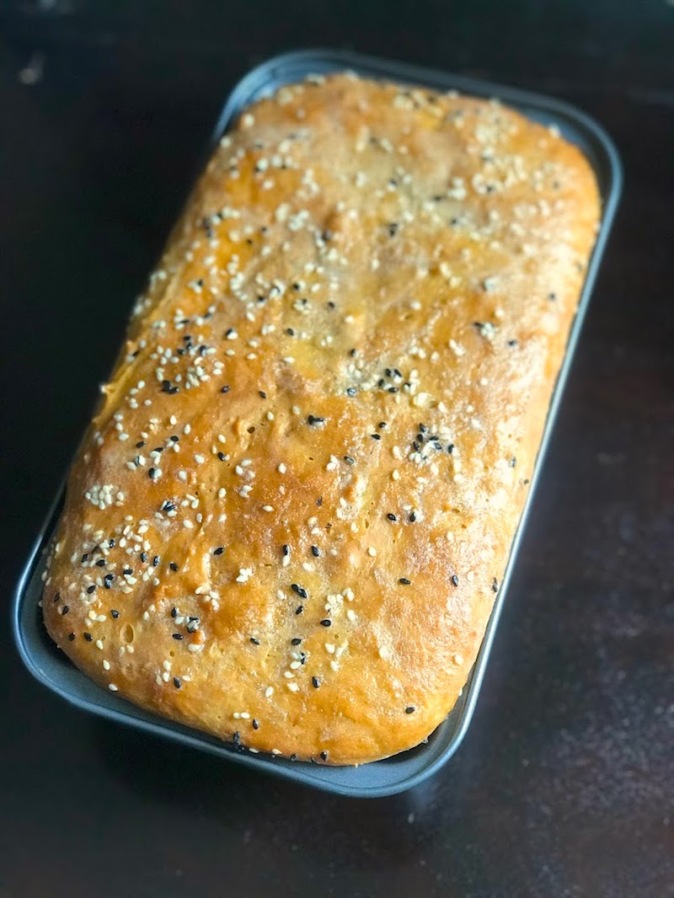
We love cooking different kinds of recipes – simple or elaborate. Inspiration in our kitchen comes from different cuisines, cultures, cookbooks and random recipe discoveries online. Sometimes the menu is influenced by our travels and at times, they are a result of conversation I strike up with people I come across or other foodie friends and of course, from instagram and blog posts of my blogger friends. For years, I have been nervous about making dough, specially for cakes. I guess it’s because there is no room for altering proportions or zany experiments in such baking. The Z-Sisters have used this ignorance of mine to their advantage. Accompanied by our dearest Lady M, they have transformed into expert bakers. They bake almost everything – cupcakes, cookies, a variety of cakes. We also bake meatloaves and regular breads at home. Amongst all the things are baked at home, nothing fills my heart with more gratitude and love than a freshly baked bread loaf just out of the oven. The act of making a simple recipe coming to such a meaningful fruition is soul satisfying.
In our initial days, we used the regular self-raising flour to make our breads (images towards the end of the blogpost captured this journey). For a baking pan, we used a steel serving container left behind by one of the caterers from some party at home! Now we have bought a non-stick loaf-baking pan. Also, we use mostly atta or whole wheat, occasionally throwing in chopped nuts, pumpkin seeds and other ingredients we fancy. And gosh, we do fancy our sesame seeds! The addition of sesame not only ups the glamour quotient of our bread loaf, but also makes the taste punchier.
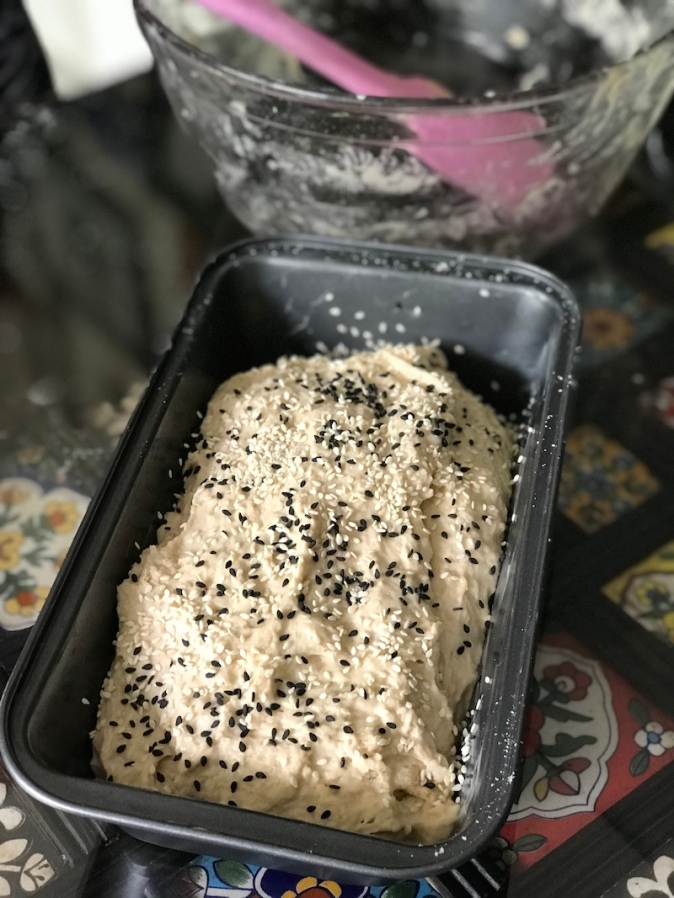
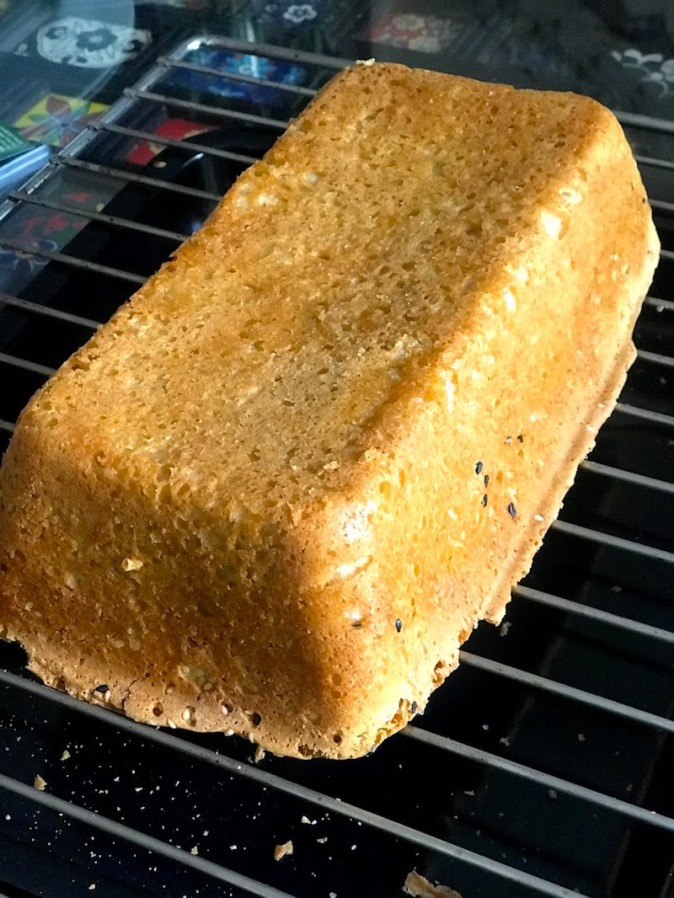

3½ cups atta/wheat flour 1 bread loaf baking pan (27cms x 15cms stainless steel)Homemade Bread with Sprinkled Sesame
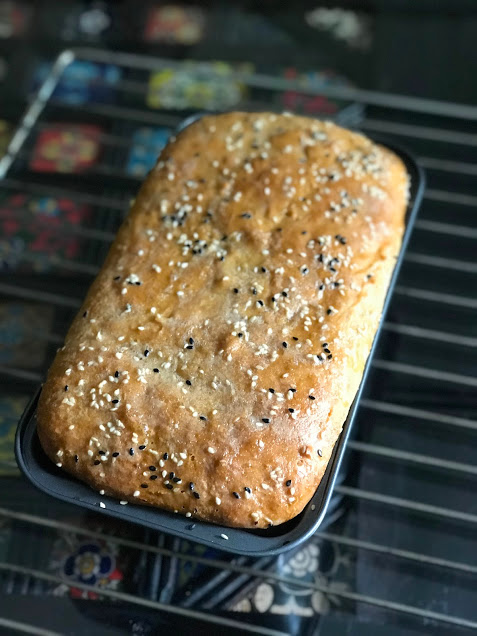
Ingredients
1 tbsp honey (we also use brown sugar sometimes)
1 ½ tsp dry yeast
1 cup of milk, room temperature
2 tbsp white oil
1 tbsp butter – for greasing the pan and also to brush the loaf once its baked
½ tsp white sesame seeds
½ tsp black sesame seeds
1 tsp salt
½ cup warm waterMethod
You can make delicious French Toasts with this home made bread or simple buttered toasts with sugar sprinkled on top!
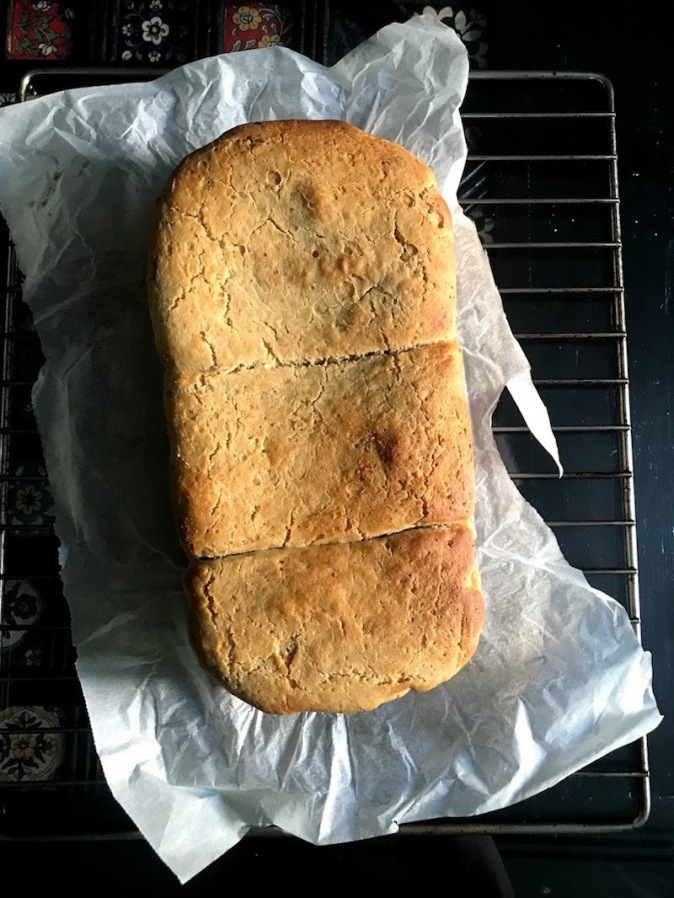

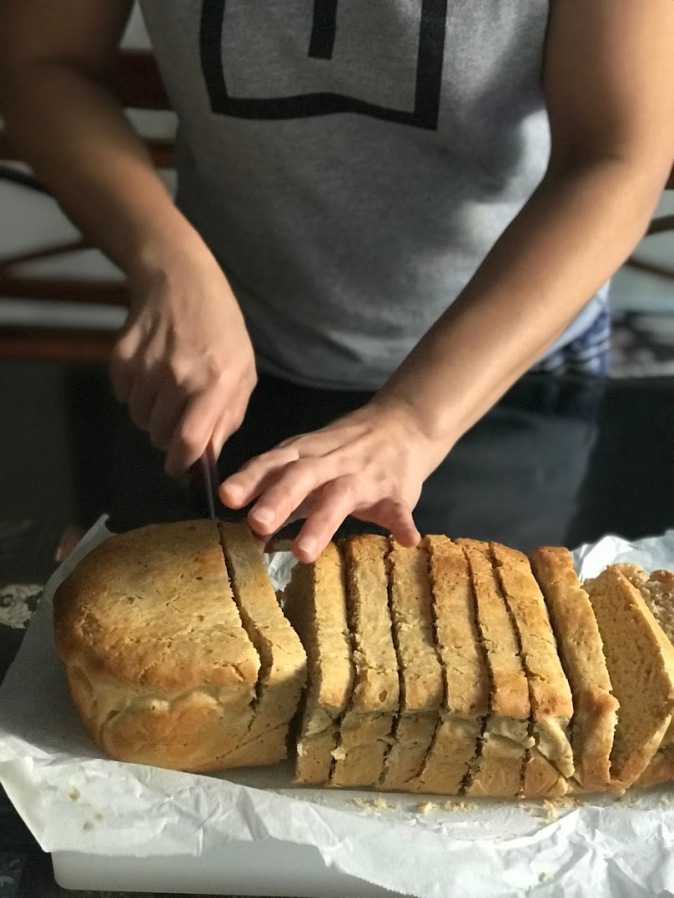
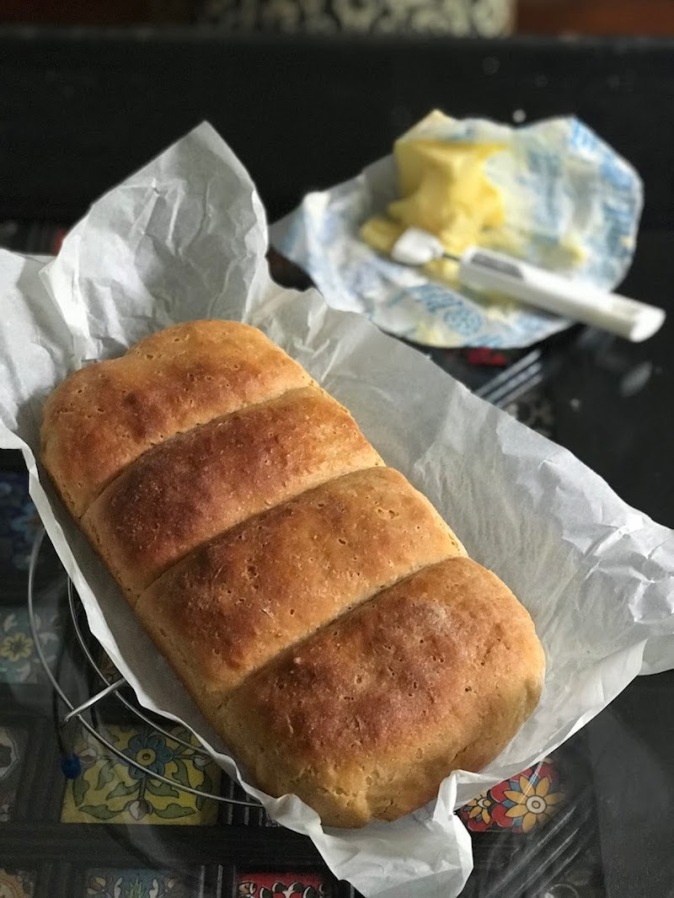
With all the efforts that are taking place for self-isolation at this hour, I feel blessed and fortunate to be able to have both the meals together at home with family. Cooking or baking is not something that we have taken up suddenly as a new activity. We have always cooked at home. However, with everybody working and studying from home, while we plan the menu nowadays, we sometimes tend to tend to forget that weekdays are actual working days. It’s not a fancy weekend meal that can be elaborate to make my crew lethargic! Working or distant school learning from home may have their technical challenges for those who aren’t initiated into it. However, it’s doable if you adhere to a similar structure and routine that entailed earlier… yes, it’s easier said than done. It’s may be challenging for some give each other spaces to work or to study, even though we all might be in close physical proximity and a nudge’s distance.
I have to say though, I am inspired by how everyone is trying to make changes and adapting to their environments daily to meet the new challenges of the hour. Much like our ever-evolving bread story… ingredients may keep changing, but the binding, purpose and soul of the bread remains the same!
Keep your menu simple, keep it delicious, keep it homemade. Do share your daily personal food stories with me and stay tuned as I share mine.
Unblogging it all… Ishita
The internet today is overloaded with information on COVID-19, do read and absorb whatever is necessary and adhere to the tips and advices that the respective authorities of your country of residence are sharing with you.
Thank you for joining me on my daily food and travel journey on Pinterest, Instagram, Facebook and Twitter!
Disclaimer: This isn’t a sponsored post, nor are there any affiliated links for any of the brands that may have been mentioned in this blogpost. The subject, story, opinions and views stated here are my own and all images are from my personal album. While you enjoy reading my posts with lot of visuals, please do not use any material from these posts.

Stuffed chilli spring rolls … because a little spiciness brings a lot of happiness in my own sweet little world!

Chillies plays such a huge role in our lives. There are chilli plants in our gardens, each plant showing off a different variety of chilli. Friends gift us chilli pickles. Some also bring back chillies from their travels. Mom-in-law once brought chillies from Kolkata packed in her suitcase. Then she lovingly dried a few of them and planted them in small pots all over the garden. A few strong ones survived, some didn’t. The ones that don’t survive are regularly replaced by newly dried seeds of chillies brought from local supermarkets. Once, the bearded biker got bhut jhalokias from one of his travels across North-East India and planted them in our garden. Also known as ghost pepper, these chillies have been certified by Guinness World Records as the world’s hottest chilli pepper, 400 times hotter than Tabasco sauce! While they didn’t survive in our Dubai garden, our love story with chillies continue in our lives – in our dinner table conversations and in our gardens. These crispy stuffed chilli spring rolls (above) were part of my special birthday menu recently, an extended version of Lady M’s regular spring rolls (below).
Speaking about our garden, we grow fresh basils, mint, coriander and chillies (obviously). We’ve grown watermelon successfully and attempted an ash gourd plant which delighted us only with its gorgeous flowers. We also tried our hands at growing strawberries which were mostly ransacked by birds. There’s an avocado tree planted from a seed of an avocado brought from Philippines that promises fruits this year. Or may be next year.
Expecting good things to bloom, ripen and taking us by surprise, is what keeps us ticking for the future. Specially love, isn’t it?
Unblogging it all… Ishita







15 long green chillies (you may use jalapeños), min 5″ long For the filling For deep fryingStuffed Chilli Spring Rolls
Ingredients
1 tbsp all purpose flour
15 spring roll pastry sheets, 5”x5”
1 cup mozzarella cheese, shredded
100 gms minced meat (we used lamb mince)
4 pods garlic, chopped
1 onion, chopped
1 tomato, chopped
1 tsp garam masala
1 tsp coriander power
1 tsp cumin powder
1 tsp chilli powder
fresh coriander leaves, chopped
1 cup white oilMethod
The internet today is overloaded with information on COVID-19, do read and absorb whatever is necessary and adhere to the tips and advices that the respective authorities of your country of residence are sharing with you. More from authentic source such as WHO: Coronavirus disease (COVID-19) advice for the public
Thank you for joining me on my daily food and travel journey on Pinterest, Instagram, Facebook and Twitter!
Disclaimer: This isn’t a sponsored post, nor are there any affiliated links for any of the brands that may have been mentioned in this blogpost. The subject, story, opinions and views stated here are my own and all images are from my personal album. While you enjoy reading my posts with lot of visuals, please do not use any material from these posts.

Homemade cinnamon rolls and a steaming hot coffee… I wish somewhere beyond the dark clouds, we could all see the rainbow that promises a life filled with simple pleasures of life, all over again!

The Z-Sisters are already one week into their remote school learning. The bearded biker also works from home currently. Our kitchen transforms into my occasional writing space, with the dear labradors snuggled at my feet. The words that are meant to form thoughts become muddled up by the aroma of Lady M’s delicious cooking. In an ideal world, this would been my ideal kind of a day. However, these days, I keep checking on the incessant whatsapp messages to reassure myself that our parents and others in our families back home and elsewhere are safe and sound. The same thought goes out for our friends, colleagues and everyone we know. While I pray for a safe world today and everyday, I’m ever grateful to all the forces ~ divine and human, that work in conjunction that are keeping us safe and alive. May our collective energy gear us towards love and hope, faith and positivity and a beautiful future ahead. Very very soon.
Until then, let us spread love and joy, hope and faith… specially over social media (that’s Instagram for me), with whatever makes our hearts dance to a {happy} beat. Enjoy your baking!
Unblogging it all… Ishita

For the dough For the filling For the dough For the frosting (you can prepare this while the rolls are cooling down) Thank you for joining me on my daily food and travel journey on Pinterest, Instagram, Facebook and Twitter! Much love – Ishita Disclaimer: This isn’t a sponsored post, nor are there any affiliated links for any of the brands that may have been mentioned in this blogpost. The subject, story, opinions and views stated here are my own and all images are from my personal album. While you enjoy reading my posts with lot of visuals, please do not use any material from these posts. Happy Cinnamon Rolls
Recipe adapted from Tastes of Lizzy T’s Homemade Cinnamon Rolls {Cinnabon Copycat}. She also shares variations of cinnamon rolls in her website along with a lot of home baking tips that might help you to hone your baking skills. This is a tried and tested recipe at home and although we have retained the original recipe, we have tweaked it slightly.
Ingredients
1 cup milk, warm
2 1/2 tsp instant dry yeast
2 large eggs, room temperature
1/3 cup butter, melted
4 1/2 cups all-purpose flour
1 tsp salt
1/2 cup granulated sugar
1/2 cup butter, melted
1 cup brown sugar
2 tbs cinnamon
1/2 cup heavy cream (for pouring over the rolls)
2 cups sugar, powdered
1/2 tbsp vanilla essenceMethod


The internet today is overloaded with information on COVID-19, do read and absorb whatever is necessary and adhere to the tips and advices that the respective authorities of your country of residence are sharing with you. More from authentic source such as WHO: Coronavirus disease (COVID-19) advice for the public

Birgu comprised of the last part of my Malta itinerary and I was already smitten by yellow limestone forts, grand harbours and azure blue waters that characterised the Maltese landscape.
Birgu, also known by its title Città Vittoriosa, is an old fortified city on the south side of the Grand Harbour in the South Eastern Region of Malta. It served as the capital city of Malta between 1530 and 1571, until Valletta was built. The city still retained its medieval flavour with cobbled alleys, stepped lanes, converted townhouses (available for rents!), elegantly renovated art and curio boutiques. The Birgu waterfront was lined with modern cafes and restaurants and buzzed with alfresco diners. Our guide Yvette led us through the quiet lanes of the town and majestic doors, fabled doorknobs, laced curtains, filigreed verandahs hanging out of charming old buildings embraced and surprised us in a slightly different manner than it did in Valletta and Mdina. The inner lanes in Birgu were narrower and cosier. They seemed rather quiet as individual tourists savoured their strolls and peeped into boutiques. In contrast, the historical Victory Square was downed by a bevy of tourists disembarking out of big tourist coaches. Our group disintegrated after a while – some went off to explore the various museums (The Maltese Maritime Museum, The Inquisitor’s Palace and there were many more), while the rest loitered into all the interesting nooks and corners that the town offered. One such discovery of mine was a space called Find the Door.
If you are visiting Malta in autumn, please don't miss Birgufest/Birgu by candlelight. The streets are lit up by thousands of candles as the event highlights Birgu’s history and architecture with activities, re-enactments, art exhibitions, concerts, popular games, discounted museum admission fees and access to popular venues of interests.


Find the Door
Find the Door is an artisanal boutique, a creative workspace cum shop showcasing a large collection of items, made by hand and sourced by artists living in Malta. Housed in a beautiful house in the Collacchio area in Birgu, this had once been a historical bakery. The boutique sold unique curios, souvenirs, artefacts, home decor, jewellery and many other interesting products. There were handmade jewellery that used natural materials made from and inspired by the Maltese Islands. The open courtyards were transformed into working space for artists and the corners were stacked with books and reading memorabilia. Once I was inside this creative maze, it was very difficult for me to refocus on the day’s itinerary in hand.
https://www.facebook.com/pg/findthedoormalta/
27 Triq It Tramuntana, Birgu




Eating in Birgu
The waterfront is lined with cafes and restaurants, so are the inner lanes and the popular squares. We came across Tal-Petut restaurant which had a great name. Apparently, the chef patron prepared and served prepared meals personally to its patrons. The restaurant served only fresh local produce and innovative Maltese food. Since this was going to be our last meal in Malta, we chose a restaurant that was located at the historical Victory Square so that we could immerse ourselves completely in the local vibe. BeBirgu was a bar and bistro of the San Lawrenz Band Club established in 1883 (yet another restaurant with an association with a historical band. Earlier in Valleta, we had a meal at Own Band Club Bar & Restaurant that was situated on the ground floor in the historical premises of a 1874 building belonging to the King’s Own Band Club). Housed in an old palace, Palazzo Huesca, a grand entrance led us through an ornate corridor into a beautiful terrace of an inner courtyard which had been transformed into a dining space. I settled in with one of the wonderful companions from the trip – an editor friend from a popular woman’s magazine. A chilled cold coffee was the perfect thirst quencher after the afternoon heat. We skipped any traditional starters and I ordered Ravjul Malti, the famous homemade Maltese Raviolis with filled with ricotta and parmesan. My companion ordered a Penne with chicken and mushroom. We loved both the pasta preparations – the aroma of fresh herbs and homemade sauces were evident.
https://www.facebook.com/Bebirgu/





The golden hue of Maltese architecture still hangs over my vision while the azure blue of the Mediterranean has seeped deep into my senses. The charm of history, medieval nostalgia, delicious food and the warmth of the people in Malta triumphs over the humidity and the heat of the season. With a flight distance that is less than seven hours, this should be my next destination for a family holiday… only this time with a definite stop over at Larnaca and a ferry ride to Sicily, not even a hundred kilometres away!
Unblogging it all… Ishita
Thank you for joining me on my daily food and travel journey on Pinterest, Instagram, Facebook and Twitter!
Disclaimer: It was my honour to be a guest of the Embassy of the Republic of Malta in the United Arab Emirates. For more info on Malta, visit www.visitmalta.com. We paid for our lunch at BeBirgu restaurant and for all our personal purchases from Find the Door. There aren’t any affiliated links in this post and the subject, story, opinions and views stated here are my own. While you enjoy reading my posts with lot of visuals, please do not use any material from these posts.

Interesting reads: Saint Lawrence Band Club, Vittoriosa

The beautiful island of Gozo awaited our arrival and we sailed amidst the scenic blue Mediterranean with the cool sea breeze sweeping across my cheeks.
The third day of our Malta itinerary (here’s my first Malta post on the fortified cities Valletta and Mdina) comprised of a day trip to Gozo, the second largest island after the main island of Malta. Unlike its sister island Comino, which has officially three residents only, Gozo is relatively large with a population of around thirty-seven thousand people.
We boarded a minivan from Sliema to reach Cirkewwa Ferry Terminal on the northern tip of Malta Island via a scenic drive along the Coast Road. The coastal road is one of the most beautiful roads in Malta and in the one and a half an hour drive, we passed quite a few beaches, bays, small seaside towns and picturesque villages. Many of them were popular destinations for locals and tourists. The quaintness of the surroundings and the gorgeous panorama charmed us all… be it St George’s Bay around the busy St Julian’s area at the start of our journey near Sliema, or Mellieħa Bay situated at a few minutes’ drive away from the ferry terminal at Gozo, our destination. The Mellieha Bay, also known as Ghadira, is the largest and one of the most beautiful sandy beaches in Malta, just off the town of Mellieha. From Cirkewwa, we hopped onto the Gozo ferry, the passenger line which plied across to the Mgarr harbour in southeast coast of Gozo every 45 minutes all year round. Once we claimed our seats on the upper deck, the next twenty minutes were spent gorging on the scenic coastlines of Maltese islands, including that of Comino.
A scenic boat trip at Dwerja Bay, admire Gozo’s beauty in its naturalness, explore Malta’s heritage and history in the Ġgantija megalithic temple ruins
The first emotional encounter that every tourist in Gozo will come across is the loss of the iconic Azure Window. Also known as Dwerja Window, the 28-metre-tall natural limestone arch in Dwejra Bay was one of the island’s major tourist destinations. On 8th March 2017, a stormy weather led to it’s sudden collapse – a major loss to Malta’s natural heritage. Although not as popular as the Azure Window, a visit to Wied il-Mielaħ Window, another limestone natural arch located at the end of the picturesque Wied il-Mielaħ valley, is a must. So is paying a homage to the Azure Window by taking a boat trip in the Dwerja Bay to see the ruins of the window. A boat trip (costing 4 euros per person) took us to a seawater lagoon through a narrow tunnel and deep caves carved out of the coralline rock formations from Dwerja. The water below us was crystal clear, throwing a glimpse of pink corals. As we reached the open sea, the floor gradually dropped away and the colour of the water deepened. The coastline was formed by steep and rugged cliffs that rose impressively from the sea.
Shrubs, dense bushes and pretty tiny flowers bloomed everywhere in the island. We came across densely branched Mediterranean thyme with purple flowers; common fennel with feathery leaves and yellow flowers; bushy capers that grew in holes in the walls and cracks on stones. Our wonderful guide Yvette, told us how capers were pickled in sea salt and vinegar and used as seasoning in many traditional Mediterranean dishes. The most common sight however, were the prickly pear cactus plants, also known as ‘bajtar tax-xewk’. The warm Mediterranean climate with long, dry summers and cool, mild winters in Malta were perfect for these cacti and its fruits were used to make everything from jams, jellies and ‘Bajtra’, the famous liqueur. Inside the Ġgantija megalithic temple complex too, we came across a lot of indigenous plants. These Neolithic temples were the earliest of the Megalithic Temples of Malta and were older than even the pyramids of Egypt. They were also the world’s second oldest existing manmade religious structures. ‘Ġgantija’ meant giant in Maltese, and the rock structures justified the name.
Gozo took pride in its well-preserved Neolithic Ġgantija temples which date back to 3600 BC. Along with the other Megalithic Temples of Malta, these ruins are among the world’s oldest free-standing structures and have been awarded the status of UNESCO World Heritage Site.
Explore Cittadella in Victoria, visit the 350 year old Marsalforn salt pans, dive into Greek mythology at the Calypso cave over the breathtaking Ramla Bay
We drove past the spectacular basilica, Our Lady of Ta’ Pinu Basilica, located on the edge of a seaside cliff a few times. Our first stop in the island was Citadella, or Castello. This fortified city in Victoria (also known as Rabat in Maltese) is the capital city of Gozo it’s first fortifications dated back to 1500 BC. The citadel is currently on Malta’s tentative list for UNESCO World Heritage sites. Like most ancient buildings in Malta, the buildings in Citadella too were built with the softer Globigerina limestone giving out its characteristic golden hue. Norman-styled windows, striking bas-reliefs and coat of arms marked the façade of the buildings. One such bas-relief depicting St Anne, mother of the blessed Virgin Mary, protector of city gates, held centre stage under the archway near the entrance. This entrance led us into the citadel through narrow winding streets. Inside, there were historic buildings and notable churches, including the magnificent baroque Cathedral of the Assumption which was built on the site of an earlier church. Keys were left inside the locks in most of the main doors – reiterating the pride of the Maltese people… everyone on the island was trustworthy. Before we proceeded towards other touristic destinations after the citadel tour, we walked to the ruined battlements to enjoy a panoramic view of Victoria and other cities in the island.
On our way to lunch, we stopped by the north coast of Gozo at Marsalforn salt pans that stretched for more than 3 kms. The coast was characterised by a unique landscape – a chequerboard of rock-cut salt pans that were more than three hundred and fifty year old. The centuries-old Gozitan tradition of sea-salt production was still carried on by a few families who had specialised in this for a few generations. We then headed off to the Calypso Cave, which was apparently the love prison of Ulysses. Located in a cliff off the village of Xaghra, the cave overlooked the beautiful beach of Ramla l-Ħamra. Although the actual cave is now closed for safety reasons, the breathtaking view from this location was worth the drive. Mentioned by Greek author Homer in his epic poem The Odyssey, the beautiful nymph Calypso, kept Odysseus as a ‘prisoner of love’ for seven years in this very cave. In his epic, Homer described Calypso’s island Ogygia (today’s Gozo), as a lush, beautiful island with a tropical feel. There were rocky cliffs with amazing waterfalls and various types of birds including owls, falcons, and sea-crows soaring over the island. By all means, Gozo fitted all the above description and more!

Eating in Gozo
Qbajjar Restaurant
Considered as one of the best local restaurants in Gozo, Qbajjar offered a spectacular view of the Qbajjar bay along with delicious lunch choices of Mediterranean and local cuisine. The restaurant offered both a la carte menu together with everyday specialities prepared fresh with locally sourced ingredients. While the daily fish catch determined the fish menu, seasonal availability of fresh produce influenced the specials. Homemade Bruschetta, thinly sliced toasted bread with garlic, tomatoes, basil, onions, olives, capers and olive oil, arrived at the table with our drinks. I tried a white wine produced in Malta – a limited edition of Caravaggio from the famous Marsovin winery. For mains, I ordered one of the restaurant’s specialities. Coniglio alla Gozitana was a signature dish – rabbit fried in garlic, peas, herbs and white wine. A traditional rabbit stew, stuffat tal-fenek was considered the national dish of Malta and it wasn’t offered in the menu that day. An delicious assortment of home made desserts like panna cotta, tiramisu and others along with a variety of home-made ice creams signed off our brilliant lunch.
https://qbajjarrestaurant.com/
Triq ix-Xwejni, Marsalforn
+356 2155 1124; Open 10:30 until 15:30 and again from 17:30 until 22:30 (last order);
Closed on Tuesdays
Buying local produce in the island
A visit to Gozo island is incomplete without visiting Ta’ Mena Estate, a family owned business which produced artisanal Gozitan food products like pickles, preserves, jams, jellies, compotes, local cheese, liqueurs and more. The estate cultivated its own vines, olives, lemons, oranges, various fruit trees, strawberries, tomatoes, melons, water melons and other vegetables. Some of the most popular buys were pure Gozo Honey, Kunserva Helwa/sweet tomato paste, Kunserva Mielha/salty tomato paste, sun dried tomatoes, wild capers in vinegar, cold pressed extra virgin olive oil, local cheese and Bajtra – the prickly pear liqueur, amongst other fruit liqueurs. We had a tasting session of local wines along with Ġbejniet, the local cheese, made from goat’s milk. The locals ate this cheese in its many forms – from salt cured and sun dried to crushed black pepper. In Ta’Mena Estate, guests could not only taste traditional Maltese food but also learn about crops, trees and traditional way of processing food in the island. I didn’t quite fancy the taste of the famous Bajtra, so I bought red wine instead, chilli infused olive oil, Qubbajt – the famous Maltese Nougat and Gozitan beeswax bath products made,
http://tamena-gozo.com/
Ta’ Mena Estate, Rabat Road Xaghra, Gozo
+356 2156 3097; closes 5pm
What is your kind of retail therapy while on travel? What do you like to buy and how do you plan your eatings?.Do you stick to familiar dishes (and popular international restaurant chains) or are you the kind who’s attracted to local food and visiting the local markets? Travelling for my family and me is another excuse to learn and explore a little bit more of the world that we live in. Although I am not very bold or wildly adventurous, I am definitely curious and open to new tastes, sights and sounds. We make a match, hopefully!
Unblogging it all… Ishita
Thank you for joining me on my daily food and travel journey on Pinterest, Instagram, Facebook and Twitter!
Disclaimer: It was my honour to be a guest of the Embassy of the Republic of Malta in the United Arab Emirates. For more info on Malta, visit www.visitmalta.com. We were hosted at Qbajjar restaurant and we paid for all our personal purchases from Ta’mena. There aren’t any affiliated links in this post and the subject, story, opinions and views stated here are my own. While you enjoy reading my posts with lot of visuals, please do not use any material from these posts.
Interesting read: Limestone country: the story behind Malta’s iconic golden hue Odysseus on Calypso’s Island

The island basked in more than 7,000 years of history, abundant sunshine, dollops of warm sea breeze and vitamin sea all around.
Fortified cities, picturesque coastlines, pretty harbours in an azure Mediterranean surrounding thronged by fishing and leisure boats alike, Malta is regal and stunning. There’s more to this tiny island-archipelago than just picturesque locales in movies like Gladiator, Troy, Angelina Jolie-Brad Pitt’s film ‘By the Sea’ or the legendary series of Game of Thrones. The country checks all the plausible boxes for an exotic travel destination – delicious food, gorgeous landscapes, archaeological relicts, architectural marvels and of course, the allure of history. Malta is the world’s tenth smallest country and boasts of three UNESCO impressive World Heritage Sites: Hypogeum of Ħal-Saflieni, the fortified city of Valletta (the smallest national capital in the European Union) and seven megalithic temples. The latter are some of the oldest free-standing structures in the world. Malta’s strategic location in the centre of the Mediterranean and the government’s earnest developmental policies are already managing to attract a lot of foreign investment too, especially in the real estate and manufacturing sectors.
A seven-hour long flight by Emirates Airline that included a small one-hour stopover in Larnaca in Cyprus, brought me to this tiny Mediterranean island. With an area covering around 300 square metres and a population less than 500,000, the size is in sheer contrast to its mighty legacy. The island basked in more than 7,000 years of history, abundant sunshine, dollops of warm sea breeze and vitamin sea all around. I fell in love with the traditional Maltese houses which had delicately filigreed wooden verandas known as ‘gallerias’, hanging out of buildings carved out of yellow limestone. This imparted a unique elegance to the landscape and I was happy to see (and relieved to learn) that the traditional style was being replicated even in the newer houses that were being built. Everywhere, urbanisation seemed rapid and checks and balances prevailed to ensure that the modern real estate developments were in sync with the heritage of the traditional architecture. History and tradition seemed to merge seamlessly into the present. The ubiquitous red telephone booths and pillar mail boxes were reminiscent of the country’s colonial past – Malta became independent as a Commonwealth realm known as the State of Malta in 1964 and it became a republic in 1974. The confluence of myriad cultures and civilisations reflected themselves in the architecture, food and culture.
We stayed in Sliema, one of the busiest commercial and social hubs in the island of Malta, also a popular area for both tourists and local residents. Originally a fishing village, Sliema today has developed into an exciting urban space with luxury hotels, modern apartment blocks, popular restaurants, pubs and cafes, boutique shops etc. The daintiness of the seaside is still maintained by picturesque cafes and restaurants located along the coastline that extended towards Ta’ Xbiex and Gżira in the South and towards St. Julian’s in the North. The latter area buzzes during the night time as we realised on one of our visits to a local pub. During our trip, we visited offices of various ministries, tourism authorities, trade commissions and it was quite apparent that Malta was doing all the right things to promote the country. Malta deserved this attention because of its history, heritage and natural beauty. It was wonderful to see the Maltese people basking in their heritage, whether it was the majestic Arlogg Tal-Lira, the traditional Maltese wall clock gilded in gold (in the picture above) that adorned every wall of prominence in a home, office or a hotel, or in their unique language – Malti, the only Semitic language written in Latin characters.
Do hop into a horse-carriage for a ride along the Sliema promenade - 'the front', just like I did with a companion. We basked in the spotlight with the traffic queueing up behind us. Savour the slow-trotting ride. Trust me, no one will ever honk or urge you to move faster - Maltese people are known for their politeness!
Mdina
The first halt in our five-day itinerary was a visit to the historic Mdina, the old capital of Malta. Also referred to as the ‘silent city’ because of the stony silence echoing through its quiet narrow alleys, the history of Mdina can be traced back to more than 4000 years. This is a car-free city and the only way to explore Mdina is on foot. The baroque styled imposing Mdina Gate right at the entrance of the walled city, gives a clear indication to the architectural beauty that lay inside. Designed by Charles Francois de Mondion and built in 1724, the Mdina Gate is also known as the Vilhena Gate, named after Grand Master Antonio Manoel de Vilhena. Inside the city, the impressive buildings with courtyards, arched hallways and formidable main doors with intricately carved doorknobs and knockers (il-ħabbata), are still inhabited by Malta’s noble families. These houses reflect a fine mix of medieval and baroque architecture and the city’s medieval name – ‘Citta’ Notabile’ or the noble city reflects that legacy. A visit to the 17th century St Paul’s Cathedral is a must, which is dedicated to the Patron Saint of Malta. Apart from an ornate gilded vault inside, the arched ceiling inside the cathedral have paintings depicting St Paul’s shipwreck. The latter is an important event in Malta’s history and the Apostle St. Paul is said to have lived here after being shipwrecked off the Maltese coasts in 60 A.D. We strolled along the quaint alleys and the strong evening sun casted long shadows on the stony façade until we reached the Bastion Square. As we stood at the edge of Mdina’s ramparts and bastion walls, far beyond the golden countryside, lay the famous Mosta Dome and the Mediterranean Sea. Considered a place of miracles, when the church was almost destroyed when a 200 kg bomb fell through the dome without exploding during a German air raid in the Second World War. All the 300 people attending morning mass were left unharmed!
If you like mystery and adventure, you will love strolling the silent city of Mdina by night when the streets are lit up by lamps. St Paul's cathedral, other landmark buildings and popular squares are lit up too. Most of the visitor attractions like St Paul’s Cathedral, the Dungeons, or the Natural History Museum can however be visited only during the day time.
Valletta
We hopped in and out of the capital city of Valletta a few times during our stay in Malta, in the capacity of both a tourist and a visiting delegate to the various ministries. Recognised as a UNESCO World heritage Site, Valletta is indeed beautiful and filled with large squares, outdoor cafes, elegant arcades, fountains, Baroque styled palaces and manicured gardens. There are statues of important people or monuments commemorating events of historical importance adorn the middle of each square. The St John’s square adjoining the St John’s Co-Cathedral, occupies the heart of Valletta and is one of the largest squares with people from all spheres of life converging at the square’s alfresco cafes. One of my most euphoric experiences in Malta was to see the largest canvas of my favourite artist of all times – Michelangelo Caravaggio’s inside the St John’s Co-Cathedral. Built between 1572 and 1577, the co-cathedral is dedicated to Saint John the Baptist and commissioned by the Grand Master Jean de la Cassière. While the exterior of the co-cathedral reflects Mannerist style of architecture, the ornate Baroque styled interior has walls intricately carved in-situ out of Maltese limestone. The vaulted ceilings and side altars have scenes depicting the life of John the Baptist. The marble floor houses the tombs of about 400 knights and officers of the Order. The oratory has one of the greatest masterpieces of Caravaggio – The beheading of Saint John the Baptist, the largest of Caravaggio’s work (370cmx520cm) and the only one to be signed by the artist. There’s another painting by Caravaggio in the oratory – Saint Jerome Writing, rumoured to be the first painting by the artist when he landed in Malta. I am a huge fan of the two famous Michelangelos – Buonarroti and Caravaggio, and one of my inspirational highlights of Malta was witnessing such an impressive work of art painted by the latter in his signature chiaroscuro style that uses strong contrasts between light and dark.
Apart from government offices and museums, the squares and the lanes are dotted by quaint bistros, souvenir shops, antique shops, retro cafes, jewellery shops selling traditional Maltese silverware, home grown fashion boutiques showcasing homegrown and international brands and many others. The coast and the harbour peeps occasionally through traditional houses and filigreed verandas, narrow lanes traversing both uphill and downhill. Valletta exudes both pride and charm and amidst all of this, the Grand Harbour stands out like a stellar showstopper, specially from the Upper Barrakka Gardens. Built on the highest point of Valletta, the arches of the ramparts and fortifications here form regal frames for portraits and selfies with the backdrop of the busy harbour lined with ocean liners, cruise ships and traditional sails. Not only does this give a vantage viewpoint of the harbour, it also overlooks the Saluting Battery. At noon and 4pm sharp, one of the restored guns is fired every day as a salute to the artillery heritage of the knights. With a history of 500 years, this is one of the oldest saluting battery still in operation anywhere in the world! Apart from Upper Barrakka Gardens, there are countless photo opportunities elsewhere in Valletta (and throughout Malta which is picturesque!). Only here, our backdrops not only reflected old world charm but also gravitas – for example, the Grandmaster’s Palace and the Aubertge de Castille that currently houses the respective offices of the President of Malta and the Prime Minister of Malta, or other historic landmarks. Whether its admiring the beautiful facades of traditional buildings, curio shops, nudging through the slow serpentine traffic of cars and scooters in the historic Republic Street or inhaling in the spectacular Valletta Waterfront with its vibrant outdoor eateries and magnificent views – savouring Valletta leisurely is perhaps the best thing to do to!
Witnessing tradition is always a novelty, so don't miss the chance to witness the Changing of the Guard Ceremony at The Palace Valletta! It is held every last Friday of the month at St George's Square in Valletta. The parade commences at 1030 hrs, with the AFM Band marching down Republic Street onto St George's Square Valletta. Here, the new guard marches out from the Main Guard in order to replace the old guard which marches out from The Palace Valletta. Following the exchange of ‘duties' the AFM Band conducts a marching display in the same square.
Eating in Malta
Fontanella Tea Garden, Mdina
This popular family-run cafe is situated at the end of the walls of the bastions and boasts of a spectacular view that overlooks the beautiful island of Malta. Although the tea room serves food and snacks, our guide Yvette shared that Fontanella is famous for its home-made cakes. Interestingly, the chocolate cake and strawberry meringue are really special and have remained unchanged for the last 41 years!
www.fontanellateagarden.com
+356 2145 4264 / +356 2145 0208; Open 10:00am until midnight daily
Caffe Cordina, Valletta
Founded in 1837, Caffe Cordina run by the Cordina family started off as a small outlet in the double-fortified harbour city Cospicua (known as Bormla in Maltese). The cafe was relocated to Valletta in 1944 and today has acquired an iconic status in Valletta. It’s a much recognisable brand with its own product lines of Maltese delicacies – gourmet products, sweets, cakes and cookies, still made in the traditional way and available at selected outlets across Malta and Gozo. One of the must-do things in Valletta is an alfresco dining at the popular cafe located in a historical premise in Piazza Regina. As we walked into the cafe to place my order, I was awestruck by the beautiful decor with gilded walls and arched ceiling. The ceiling is embellished with paintings by the renowned Maltese painter Giuseppe Cali and there are many other beautiful paintings specifically commissioned by the Cordina family. There are seatings inside the cafe as well as outside in the prominent square and we chose to sit outside. The menu was extensive and offered a variety of snacks, savouries and desserts, a breakfast menu and also traditional Maltese food like braised rabbit, Bragioli and others. The halt here was a mini filler for us, so we stuck to Maltese Pastizzi, the traditional savoury pastry. The fillings for the pastries varied from ricotta cheese, mushy peas or a minced beef filling. Our guide Yvette suggested the Rum Baba, a rum-soaked light cake filled with custard cream and fresh fruit. The soaring heat of the midday sun gave us a valid excuse too for ordering a Chilled Coffee with ice cream as an accompanying coolant!
www.caffecordina.com
244 Republic Street, Valletta
+356 2065 0400; Open 8:00am until 7:00pm Mondays to Saturdays and until 4:00pm on Sunday
MUŻA
Our first lunch in Malta was in MUŻA, a very special restaurant. MUŻA Restaurant is housed in the historic 16th century building Auberge D’Italie, which was the seat of the Italian knights of the Order of St John. MUŻA is new National Museum of Art in Malta and is Heritage Malta’s flagship project to carry forward the legacy of Valletta’s selection as the European City of Culture for 2018. The restaurant has three main areas, each having a rich history of their own. The Bar-Cafe area is located within what once was the Auberge’s Kitchen; the Donato Room which is the main dining area and where lower ranking officials of the Order of St. John responsible for the day to day running of kitchen and services would have lived during the times of the Order of St John; and the open space of a Mediterranean Courtyard, a public space with a 17th century arched well at the centre of the courtyard. As the word MUŻA suggests, ‘inspiration’ in Maltese, every dish in the restaurant is inspired by an artwork on display in the galleries. The menu also emphasises on fresh, home grown and seasonal produce. We sat in the elegantly decorated Donato Room, the metal-work chandelier casting a delicate floral pattern onto the burnt sienna walls. I ordered ‘The Stone Mason’s Sack’, inspired by the artwork The Stone Masons by Pietro Paula Caruana. It was a linguine dish with spicy Maltese sausage, sun-dried tomatoes and homemade sauce. The dishes ordered by my companions – for example, ‘Olga’s Fish’ was a poached fresh fish with lemongrass court bullion and tomato salsa, inspired by Edward Caruana Dingli’s Olga Galea Naudi; Abstract by Willie Apap that represented dynamic and powerful circular forms very aptly described the ‘Taco Hard Shells’; a salad dish with traditional Maltese cheese Ġbejna or cheeselet, duck, preserved celery, salted tomatoes, fresh herbs was represented by the Giorgio Preca’s Maltese Folk Characters. The mains came with a selection of sides – sautéd vegetables, salads, french fries or roasted potatoes. The presentation, look and feel of the dishes were inspired by the textures, shapes, colours, elements and stories of the artwork that represented the dish. It was here that we got introduced to Aperol Spritz, the popular local cult drink made with bitter orange, and Kinnie, the Maltese bittersweet carbonated soft drink brewed from bitter oranges and wormwood extracts.
www.muzarestaurant.com.mt
Auberge D’Italie, Valletta, Malta
+356 79790900; Open 10:00am – 9:30pm Sundays to Thursdays and until 10:00pm on Fridays and Saturdays
Own Band Club Bar & Restaurant
This bar and restaurant situated on the ground floor in the historical premises of a 1874 building belonging to the King’s Own Band Club. The band was originally founded in 1874 and immediately found a lot of patrons and established established itself as one of the leading band clubs in Malta. In 1901, it became known as the King’s Own Band Club after receiving the Royal consent. The ambience inside is both warm and lively with blue and white table settings and framed photographs of momentous events lining up the staircase. The kitchen is helmed by the award-winning female chef and restauranteur Roberta Preca (of Palazzo Preca fame) and the menu offers both Mediterranean and traditional Maltese cuisine and the ‘specials’ changed every fortnight. We started off with fresh snails served with a squeeze of lemon and local calamari seasoned and grilled and served on a bed of salad. We ordered a few signature dishes off the extensive menu, but the showstoppers were definitely the Lobster Sizzler and Sea Bass Al Sale, a whole sea bass encrusted in sea salt and set on fire by the table-side!
www.kingsownbandclub.org
+356 21230281; 274 Republic Street, Valletta
Open 8:00am – 11:00pm daily with live music on Mondays, Wednesdays and Sundays.
The Chophouse
We ushered in the spectacularly lit up skyline of Valletta across the harbour at dusk, as we sat at a long table in the wall-to-wall glass windowed terrace of The Chophouse. Situated on the picturesque peninsula Tigné Point, this was renowned to be Malta’s leading meat restaurant. Apart from boasting of being the island’s largest charcoal grill, selected cuts of Aberdeen Angus and Scottona beef from Italy were dry aged in-house. The temperature controlled wine cave in the restaurant stocked an impressive selection of over 350 wines from all over the world. The charm of travelling is to seek local flavours and so we sipped on Maltese red wine from the local brand Merlqot. Made from a blend of sustainably farmed Cabernet Sauvignon and Merlot grapes, it was vinified in a wine estate at Ta’ Qali, Malta’s agricultural heartland. We were treated to a platter of signature assortments that had been curated specially for us. We started off with the aubergine dish that has its origin in Sicily – Parmigiana di Melanzane, with a rich taste of sweet tomatoes, basil, mozzarella and parmesan cream. A zucchini carpaccio with sheep’s cheese on toasted homemade bread and a pasta in aubergine purée, parmesan cheese and coffee salt followed soon. A Chateaubriand platter served with a classic Béarnaise sauce gave us a fine taste of the quality of the meat that The Chophouse so boasted of. A pan-fried Gurbell (brown meagre) platter with garlic aioli, fennel and radish introduced us to delicate flavours of one of the most popular local fish available locally. The dessert consisted of an assorted platter of the traditional Imqaret and Maltese Lemon Cake with drizzles of home made lemon curd, and served with icecream. While Imqarets were Maltese sweets made with pastry and a filling of dates, I was told that the moist Maltese Lemon cake was a Christmas speciality.
www.chophouse.com.mt
+356 2060 3355; Open 7:00pm-11:00pm Mondays to Saturdays and 12:00pm-3:00pm and 7:00pm – 11:00pm on Sundays
Tigne Point, Censu Xerri, Sliema
Ta’ Kris Restaurant and Maltese Bistro
The concierge at our hotel suggested Ta’ Kris when I was searching for a restaurant that served home style Maltese food. What a brilliant find this was! Situated in one of the oldest and largest bakeries in Sliema, my companion and I arrived to the restaurant on a horse carriage. The restaurant was busy and had an innate charm. Old coloured Maltese tiles, shaded walls and dark Maltese furniture added a lot of warmth. The old features of the bakery had been retained and we were greeted with a all-ladies staff. We were two of us and decided at the very onset that we’ll dive into the main course and stick to the signature dishes. Thus arrived at our table, Dad’s Famous Bragioli, a traditional Maltese dish with slices of beef stuffed with forced meat and slow cooked in red wine, herbs and tomato sauce. The Veal Escalopes came with tender and succulent slices of veal sandwiched with ham and cheese and was served with a creamy sage and wine sauce. We also ordered the traditional Ravjul Malti where the homemade raviolis were filled with rich ricotta, parsley and dipped in a thick and tangy tomato sauce. Although the staff appeared extremely busy initially and it took a bit of time for us to garner some attention, once we were ‘enlisted’, the experience at Ta’ Kris was definitely one of my culinary highlights of the trip.
www.takrisrestaurant.com
+356 2133 7367; Open 12:30pm until 11:00pm daily
80 Fawwara Ln, Sliema, Malta
Hole in the Wall
“We’re a small village bar, it’s very difficult for us to accept reservations. Come & squeeze in!” That’s the inviting tagline from the oldest bar in Sliema – literally a hole in the wall established in 1922. Originally used as stables and later sold as a pub, The Hole in the Wall pub initially had no seating arrangement and offered only take-away wine from huge vats. “I’ll see you down The Hole” that’s what the pilots and cabin staff of British Airways who stayed over-night between flights in the nearby Imperial Hotel and most frequented the pub would always say… and that’s how the story of this little pub began. It still seemed to be the same – a small space with practically no seating. With craft beers, gins, cocktails, toasties, selected desserts and some live music on offer, stumbling upon this ninety (plus) year old local neighbourhood hangout was quite a delightful discovery!
+356 99834378; Open 10:30am until 1:00am from Mondays to Fridays and from 5:00pm until 1:00am on Saturdays and Sundays
Don’t leave the island without a ‘gentle’ shopping spree
Door knockers and doorknobs to start with… yes, I wish I could bring home one of those ornately designed mermaids or dolphins that could claim a place on our main door in our Dubai home! Or what about Arlogg tal-Lira, the traditional Maltese wall clock? The next on my list is the delicate filigreed silver jewellery. Although originating in ancient Greece and Rome, this type of jewellery is considered a specialty in Malta are still handmade by artisans. Shops are aplenty and prices negotiable, although I ended up buying from an exclusive boutique shop in Valletta. The most popular designs are the silver-laced earrings, bracelets or neckpieces, and of course, the eight-pointed Maltese cross. Traditional Maltese glassware is also a Maltese speciality. Blow glass shaped by hand into pieces of decoration or forms of utility is a traditional technique that takes a lot of pride in the island. Most popular and credible among all is Mdina Glass, the first glass company in Malta which was formed in 1968. I also found a large variety of pastry moulds, trays, cake tins in glass showcases across Valletta. The shapes and designs were very interesting. These were from Pace Pittsform Products, a Maltese brand established in 1940 which specialised in mass production of pastry tins and bakery ware from mild steel, stainless steel and aluminium. Regarding edible purchases, do hop onto my next post on Gozo where we visited an incredible artisanal food-store!
I would love to hear that I have inspired you all to travel to Malta, one of the most beautiful island countries that I have been to so far… and do stay tuned for the next posts where I unravel this Mediterranean gem a bit more!
Unblogging it all… Ishita
Disclaimer: It was my honour to be a guest of the Embassy of the Republic of Malta in the United Arab Emirates. For more info on Malta, visit www.visitmalta.com. While we were hosted at the various restaurants, the meals at Caffe Cordina, Ta’ Kris and Hole in the Wall were self paid. There aren’t any affiliated links in this post and the subject, story, opinions and views stated here are my own. While you enjoy reading my posts with lot of visuals, please do not use any material from these posts. Do join me on my daily food and travel journey on Instagram, Facebook, Twitter and Pinterest.
Interesting Reads: Maltese clock for their homes(Times of Malta) MALTA: The Limestone Experience

Colour is my day-long obsession and torment ∼ Claude Monet

I love this time of the year. All the universal forces seem to collide together to align all the things that I love – festive colours of Holi, magical full moon, new energy and fresh vibration of spring (equinox and all those things) and a bit of celebration. Because… my birthday somehow manages to glide into it all every year! At work front too, we had a bit of a shuffle as FoodeMag dxb rebranded itself to FoodeMag ( here’s a small read) – a new logo and new direction to support our original vision.
I’m a sucker for celebrations and so we did celebrate. We have a small group of friends in Dubai, an extended family of sort since a long time. We celebrate all our personal milestones together – big or small, with home cooked meals and some cracking up moments. The Holi cum birthday get-together wasn’t any different. Our hostess Sumana, an amateur chef and a keen foodie, said that she kept the menu simple. Deemer devil, the Bengali version of scotch eggs, luchi (here’s my ode to luchi please) accompanied by ghugni, dried yellow peas cooked in gravy, comprised our late breakfast menu (say around 2 pm!). Lunch was traditional – steaming white rice, shukto, dhokar dalna, kasha mangsho and the exotic daab chingri, a subtly flavoured mustard prawn cooked inside tender Thai coconuts. Sumana created an epic dessert fusion, a combination of three traditional festive sweets – Gajar ka Halwa with Rabri Mousse and Shahi Tukda. It not only looked spectacular but tasted divine. Long after I reached home, as I was going through the photos of the afternoon madness and the delicious sit-down, I knew that I had to share the recipe in my blog. I mean, immediately! So, here is Sumana’s tried and tested recipe that she kindly gave a structure to, over whatsapp (you know how we home cooks cook mostly – all ingredients go as per andaj, personal judgement) – even after such a long tiring day.


Gajar ka Halwa Rabri Mousse Shahi Tukda Gajar ka Halwa Rabri Mousse Shahi Tukda *Mawa or Khoya is easily available in many Indian sweet shops in Dubai – for example, Puranmal sells mawa at Dhs 63/kg. It’s also available in Lulu supermarket. I have an exclusive dekchi, a flat-bottomed cooking pot for making any dessert that uses milk as an ingredient. Milk is such a delicate ingredient that it tends to absorb even the slightest smell of spices from the pot. Gajar Ka Halwa with Rabri Mousse and Shahi Tukda

Ingredients
4 tender carrots, grated
full cream milk, enough to cover the grated carrots
200 gms mawa (thickened unsweetened milk)*
3-4 tsp milk powder (S used Nido)
1 small cup sugar
4 cardamoms, crushed into powder
1 tbsp pistachios, chopped
4 tsp ghee (S used Aseel)
1 lt full fat milk
250 gms mawa
400 gms mascarpone cheese (S used Lat Bri)
150 gms or 4 tsp heavy cream
200 gms sweetened milk
sugar (as per taste)
4 cardamoms, crushed into powder
pinch of saffron
1 small packet of unflavoured gelatine, mixed in 4tsp warm water
4 pieces white bread, sides removed and diagonally cut into half
4 tsp ghee
1/2 cup sugar syrupMethod


BTW, all my friends are great cooks. In fact, some of my girlfriends are dessert specialists of the highest order. From traditional, fusion, new creations – they conjure up sheer fantasies all the time. They did the same that day too. For example, Lipi’s traditional Malpoa and Rupa’s Monomohini – the melt in the mouth kanchagolla with a filling of nolen gur and narkel, season fresh date jaggery and coconut. These were lapped up during breakfast itself as we immersed in the colour madness. Another friend Tito, recreated the traditional almond drink Thandai, a Holi speciality, following Sanjeev Kapoor’s recipe. Finally, a traditional payesh made by Sumana and Lady M’s homemade chocolate moist cake signed off my formal birthday ceremony. It was an afternoon filled in an insane colour riot – enjoy the colour blast below!





Holi wasn’t the only reason for my colour riot over this weekend. I had a VIP invite from Bupa Global for the prestigious Art Dubai which took place in Madinat Jumeirah. This was the 13th edition of the international art fair in which more than 90 galleries from over 40 countries all across the world showcased their artists. I witnessed the works of some of my favourite Indian stalwarts like M.F. Hussein, Paresh Maity, Ganesh Pyne, Anjolie Ela Menon, Subhash Haloi, Francis Newton Souza and many others. On that same night, we booked into another spectacular event, as a family. A full moon drumming session in the desert with Dubai Drums. Although the moon was shy and refused to come out for most of the time we were there, drumming together in a group of more than 100 people, is one of the most liberating things that I had done. It was a brilliant foreword to the colourful birthday celebrations that I was headed for with my friends the next day. My inner child is absolutely thrilled and I feel really blessed to be surrounded by so much love, sweetness and colours!
Unblogging it all… Ishita
PS: My friend Sumana Haldar is the Managing Partner of http://www.etutorhome.com and http://www.ngeinitiative.com – two interactive educational platforms. What tickles my fancy (and inspires me) is that this friend of mine took her passion for cooking to the next highest level by doing an Amateur Chef course recently from International Centre for Culinary Arts (ICCA) in Knowledge Village. There’s no age to start learning something you want. Just go ahead and book into that course that you have always wanted to do!
Disclaimer: This isn’t a sponsored post, nor are there any affiliated links for any of the brands that have been mentioned in my blogpost. The subject, story, opinions and views stated here are my own and all images are from my personal album. While you enjoy reading my posts with lot of visuals, please do not use any material from these posts. Thank you for joining me on my daily food and travel journey on Instagram, Facebook, Twitter and Pinterest!
Try these dessert recipes from my blog: Gajorer Payesh or Carrot Pudding Moong Daaler Payesh or Yellow Lentil Pudding Bhapa Mishti Doi Gulab Jamum Rabri Other reads:How to make Thandai | Sanjeev Kappor Celebrate Holi with colourful recipes across the world |FoodeMag Holi in Nandgaon, Mathura and Vrindavan |FoodeMag Holi | Wiki Braj | Wiki Art Dubai DubaiDrums



























































































































































































































































